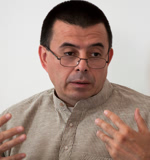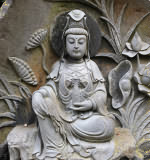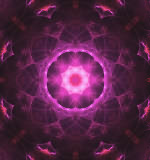Ṣaṭtriṁśattattvasandoha (Шаттримшаттаттвасандоха) - Недвойственный Кашмирский Шиваизм
Совокупность 36 категорий
|
Introduction
Приветствую, это опять я, Габриэль Pradīpaka. "Ṣaṭtriṁśattattvasandoha" буквально означает "Масса или совокупность (sandoha) тридцати шести (ṣaṭtriṁśat) таттв, или категорий (tattva)". Тридцать шесть таттв являются принципами, или категориями, из которых состоит всё вселенское Проявление. Этот текст был составлен мудрецом Amṛtānandanātha в 12ом веке нашей эры. В свою очередь, комментарий, который я представляю, насколько мне известно, был написан Rājānakānanda в 17ом веке. Эти авторы не так хорошо известны, как Abhinavagupta, Kṣemarāja, Vasugupta и пр., отсюда мои сомнения по поводу дат. Кроме того, я не уделяю этому слишком много внимания, поскольку, по моему мнению, время всегда не имеет значения.
Настоящее Писание состоит из двадцати одной строфы (бордового цвета). Комментарий написан простой прозой (зелёного цвета). Существуют и другие Писания, посвящённые таттвам, например, знаменитая Parāprāveśikā, написанная знаменитым Kṣemarāja.
Несмотря на то, что будет много пояснительных примечаний, я настоятельно рекомендую сверяться с Таблицей Таттв при прочтении этого Писания, чтобы иметь обобщённое знание о таттвах. Также для получения более глубоких знаний о них рекомендую подраздел "Трика Введение" [Трика 1, Трика 2, и т.д.] в разделе "Трика".
Наконец, как выразился Rājānakānanda в конце своего комментария: "Iti śivam" - "Да будет благополучие (для всех)!".
Важно: Всё, что заключено в скобки или выделено курсивом внутри перевода, было добавлено мною, чтобы придать определённой фразе или предложению законченный смысл. Также, мои дополнительные пояснения выделены двойным тире (--...--). Обращаю внимание, что у меня есть только санскритская версия Ṣaṭtriṁśattattvasandoha, т.e. нет других переводов, транслитерации и т.д. Таким образом, мне придётся довериться Милости Śiva и своему собственному скудному знанию санскрита и Трики. Однако, если вы являетесь знатоком санскрита, владеющим системой Трики, и обнаружили какие-то ошибки или неверное толкование, пожалуйста, напишите мне. Заранее благодарю!
Строфы 1-7
यदयमनुत्तरमूर्तिर्नजेच्छयाखिलमिदं जगत्स्रष्टुम्।
पस्पन्दे स स्पन्दः प्रथमः शिवतत्त्वमुच्यते तज्ज्ञैः॥१॥
ईह हि स्वतन्त्रशिवाद्वयदर्शने परमेश्वरः स्वतन्त्रश्चिद्घनसंवित्स्वभावः स्वया स्वातन्त्र्याख्यया शक्त्या सततं शिवादिधरण्यन्ततत्तद्भुवनभूततत्त्वात्मना क्रीडनादिशीलत्वात्कृत्यपञ्चकविधायी वस्तुतः क्रमराहित्येऽपि विश्वसृष्टावाभासनमात्रसारेण पारमार्थिककार्यकारणभावेन क्रममप्युद्भावयननाख्यत्वेऽपि स्वेच्छयैव स्वात्मभित्तौ तत्तच्छिवादितत्त्वाभिख्यामवभासयति। तथात्वेऽपि षट्त्रिंशत्तत्त्वमयकुलस्वरूपपरामर्शनादाखण्ड्येन विश्वभरितां स्वचमत्कारविमर्शसारामनुत्तरानन्दघनावस्थां नोज्झतीति वास्तवाशयावबोधनाय कश्चिन्महामाहेश्वरः परमेशशक्तिपातानुगृहीतः तत्त्वक्रमप्रक्रियामार्याभिरेकविंशत्या समुपनिबबन्ध — यदयमित्यादिना। अनुत्तरमूर्तेर्भगवतः परमेश्वरस्य प्रकाशघनस्वात्मैकात्म्येनावस्थितं विश्वं सिसृक्षोः दर्पणनगरवत्स्वेच्छयैव स्वात्मन्याद्या प्रोन्मिमीलयिषावस्था शिवतत्त्वव्यपदेश्या पञ्चशक्तिनिर्भरत्वात्स्वातन्त्र्याच्चिदादिप्राधान्येन क्रमशः शुद्धाध्वनि तत्त्वसृष्ट्यवभासनं मायाविद्यादेः संवित्प्रकाशघनपरमशिवाद्व्यतिरेकानतिरेकविकल्पैरुपहतत्त्वात्स्वातन्त्र्यमेव केवलं विश्वोत्पत्तिसंहरणादौ मूर्धाभिषिक्तम् — तत्तदनन्तशक्तिनिचयानां क्रोडीकारित्वाद्वक्ष्यमाणेऽपि तत्तद्रूपोपग्रहणे स्वातन्त्र्यामुक्तत्वान्न प्राच्यस्वभावापायः॥१॥
Yadayamanuttaramūrtirnijecchayākhilamidaṁ jagatsraṣṭum|
Paspande sa spandaḥ prathamaḥ śivatattvamucyate tajjñaiṭ||1||
Iha hi svatantraśivādvayadarśane parameśvaraḥ svatantraścidghanasaṁvitsvabhāvaḥ svayā svātantryākhyayā śaktyā satataṁ śivādidharaṇyantatattadbhuvanabhūtatattvātmanā krīḍanādiśīlatvātkṛtyapañcakavidhāyī vastutaḥ kramarāhitye'pi viśvasṛṣṭāvābhāsanamātrasāreṇa pāramārthikakāryakāraṇabhāvena kramamapyudbhāvayananākhyatve'pi svecchayaiva svātmabhittau tattacchivāditattvābhikhyāmavabhāsayati| Tathātve'pi ṣaṭtriṁśattattvamayakulasvarūpaparāmarśanādākhaṇḍyena viśvabharitāṁ svacamatkāravimarśasārāmanuttarānandaghanāvasthāṁ nojjhatīti vāstavāśayāvabodhanāya kaścinmahāmāheśvaraḥ parameśaśaktipātānugṛhītaḥ tattvakramaprakriyāmāryābhirekaviṁśatyā samupanibabandha - Yadayamityādinā| Anuttaramūrterbhagavataḥ parameśvarasya prakāśaghanasvātmaikātmyenāvasthitaṁ viśvaṁ sisṛkṣoḥ darpaṇanagaravatsvecchayaiva svātmanyādyā pronmimīlayiṣāvasthā śivatattvavyapadeśyā pañcaśaktinirbharatvātsvātantryāccidādiprādhānyena kramaśaḥ śuddhādhvani tattvasṛṣṭyavabhāsanaṁ māyāvidyādeḥ saṁvitprakāśaghanaparamaśivādvyatirekānatirekavikalpairupahatattvātsvātantryameva kevalaṁ viśvotpattisaṁharaṇādau mūrdhābhiṣiktam - Tattadanantaśaktinicayānāṁ kroḍīkāritvādvakṣyamāṇe'pi tattadrūpopagrahaṇe svātantryāmuktatvānna prācyasvabhāvāpāyaḥ||1||
Этот самый (yad ayam) Anuttaramūrti --букв. Тот, чья форма — Высшая Реальность-- (anuttara-mūrtiḥ)1 вибрировал (paspande)2 , согласно Своему собственному желанию (nija-icchayā) проявить (sraṣṭum) весь (akhilam) этот (idam) мир (jagat). Те, кто знает (jñaiḥ) этого (Anuttaramūrti) (tad), называют (ucyate) эту (saḥ) первую (prathamaḥ) Вибрацию (spandaḥ) Śiva-таттвой --букв. категорией под названием Śiva-- (śiva-tattvam)||1||
Здесь (iha), несомненно (hi), с недвойственной (advaya) точки зрения (darśane) (рассматривается) независимый (svatantra) Śiva (śiva), (этот) свободный (svatantraḥ) Всевышний (parama) Владыка (īśvaraḥ), сущностной природой которого (sva-bhāvaḥ) является Saṁvid (saṁvid), а именно, компактная масса (ghana) Сознания (cit), (который) выполняет (vidhāyī) группу из пяти (pañcaka) актов (kṛtya) посредством Своей собственной (svayā) Силы (śaktyā), известной как (ākhyayā) Svātantrya, или Абсолютная Свобода (svātantrya), которая постоянно (satatam) состоит из (ātmanā) различных (tad tad) миров (bhuvana), живых существ (bhūta) (и) таттв, или принципов (tattva), начиная с (ādi) Śiva --первой категории-- (śiva) (и) заканчивая (anta) Dharaṇī, или Землёй --последней категорией-- (dharaṇī). (Он делает это, т.е. выполняет этот пятиричный акт,) потому что у Него есть привычка (śīlatvāt) играть (krīḍana) и т.д. (ādi)3 . На самом деле (vastutas), хотя (api) последовательность (krama) во вселенском Проявлении (sṛṣṭau) отсутствует (rāhitye), Он вызывает возникновение последовательности (kramam api udbhāvayan) через настоящую (pāramārthika) связь (bhāvena) причины (kāraṇa) (и) следствия (kārya), чьей сущностью (sāreṇa) является просто (mātra) освещающая вспышка (ābhāsana)4 . Хотя (api) (в Нём) нет ни имени, ни аспекта (anākhyatve), Он проявляет (avabhāsayati) в соответствии со своей собственной (sva) волей, или желанием (icchayā eva) названия и красоту (abhikhyām) в различных (tad tad) таттвах, или категориях (tattva), (таких как) Śiva (śiva) и т.д. (ādi), (которые проявляются) на заднем плане --букв. "на стене"-- (bhittau) Его (sva) Самости (ātma)5 |
(Однако) даже (api) в таком состоянии (tathātve) --т.e. даже отобразив эту вселенную--, полностью овладев (parāmarśanāt ākhaṇḍyena) природой (sva-rūpa) группы (kula), содержащей (maya) тридцать шесть (ṣaṭtriṁśat) принципов, или категорий (tattva), Он (никогда не) (na) покидает (ujjhita) состояния (avasthām) (бытия) компактной массой (ghana) Высочайшей (anuttara) Радости (ānanda). (Он никогда не покидает) Свою (sva) сущность (sārām) как Vimarśa (vimarśa), а именно, Camatkāra, или Блаженство Высшего Я-Сознания (camatkāra), которое наполнено (bharitām) всем (viśva)6 . Таким образом (iti), чтобы научить (avabodhanāya) истинным (vāstava) значениям (āśaya), некто --т.e. Amṛtānandanātha, автор этого Писания Ṣaṭtriṁśattattvasandoha-- (kaścid), (который был) великим (mahā) преданным Великого Господа --т.e. Maheśvara, или Śiva-- (māheśvaraḥ) (и был) удостоен (anugṛhītaḥ) нисхождения (pāta) Śakti, или Силы (śakti), (дарованной) Всевышним (parama) Господом (īśa), написал (samupanibabandha) произведение (prakriyām), (имеющее дело с) последовательностью (krama) таттв, или категорий (tattva) в виде двадцати одной (строфы) (ekaviṁśatyā) в размере Āryā (āryābhiḥ), начиная (ityādinā) (со слов) "Этот самый" (yad ayam)7 |
Вселенная (viśvam), (возникшая) из Того, кто желает проявить (её) (sisṛkṣoḥ) в Своей собственной (sva) Самости (ātmani) (и) в соответствии со Своей собственной (sva) волей, или желанием (icchayā eva) как (vat) город (nagara), (отражённый) в зеркале (darpaṇa), пребывает (avasthitam) в единстве, или тождестве (aikyātmyena) с Его (sva) Сущностью (ātma), т.e. с компактной массой (ghana) Света (prakāśa) Всевышнего (parama) Владыки (īśvarasya), (именуемого также) Bhagavān --Благоприятный-- (bhagavataḥ), или Anuttaramūrti --Тот, чья форма является Высшей Реальностью-- (anūttara-mūrteḥ). Первое (ādyā) состояние (avasthā), (которое Он) желает проявить (pronmimīlayiṣa), известно как (vyapadeśyā) Śiva-таттва, или категория, называемая Śiva (śiva-tattva)8 . Поскольку (Он) наполнен (nirbharatvāt) пятью (pañca) śakti-s, или силами (śakti), посредством (Его) Абсолютной Свободы (svātantryāt) постепенно (kramaśas) проявляется (avabhāsanam) излучение (sṛṣṭi) таттв, или категорий (tattva) в чистом (śuddha) курсе, или пути (adhvani), главным образом (prādhānyena), как Cit (cit) и т.д. (ādi)9 . (Затем), поскольку Она --т.e. Svātantrya-- поражена, или затруднена (upahatatvāt) мыслями (vikalpaiḥ) о неполноценности (anatireka) (и) отделённости (vyatireka) от Paramaśiva --Высшего Śiva-- (parama-śivāt), или компактной массы (ghana) Света (prakāśa) (и) Сознания (saṁvid) из-за Māyā --шестой таттвы, или категории-- (māyā), Vidyā --восьмой таттвы-- (vidyā) и т.д. (ādeḥ), только (kevalam) Svātantrya --Абсолютная Свобода Господа, т.е. Его божественная Śakti-- (svātantryam) действительно (eva) (заслуживает того, чтобы быть) возведённой на трон (abhiṣiktam) как Высшая (Сила) (mūrdha) в проявлении (utpatti) (и) растворении (saṁharaṇa) вселенной (viśva) и т.д. (iha). (Другими словами, Абсолютная Свобода Господа, или Svātantrya заслуживает такого положения), поскольку Она является Владычицей (kroḍī-kāritvāt) различных (tad tad) (и) неисчислимых (ananta) множеств (nicayānām) śakti-s, или сил (śakti)10 . Поскольку (Он) облачён (āmuktatvāt) в Svātantrya, или Абсолютную Свободу (iha), (поэтически говоря,) нет (na) отступления (apāyaḥ) от (Его) прежней (prācya) сущностной природы (sva-bhāvaḥ) даже (api) в (Его) акте принятия (upagrahaṇe) различных (tad tad) форм (rūpa), который --т.е. Его акт принятия различных форм-- будет описан в дальнейшем (vakṣyamāṇe)11 ||1||
1 "Anuttaramūrti", или "Тот, чья форма (mūrti) является Высшей Реальностью (Anuttara)" — это эпитет Paramaśiva, Высшего Śiva, или Абсолюта. Поскольку "Anuttara" — всего лишь техническое название гласной "a", то другой альтернативный перевод может быть таким: "Тот, чья форма (mūrti) является гласной "a" (anuttara)" ![]() .
.
2 "Paspande" — это 3ье лицо ед. числа, Репликативное совершенное время корня "spand" (вибрировать, пульсировать и т.д.). Совершенное время указавает на отдалённое время, т.e. "Это вибрировало давным давно". Интересно ![]() .
.
3 Слово "tántra" означает "зависящий от", когда оно находится в конце сложного слова. В свою очередь, "sva" означает "свой" и т.п. Таким образом, "svatantra" означает: "тот, кто зависит от самого себя". Поэтому я написал в переводе "независимый" и "свободный". Итак, этот Господь (Ты!), который независим и чья сущностная природа есть Saṁvid, или компактная масса Cit, или Сознания, выполняет пятиричный акт, т.e.: проявление (sṛṣṭi), поддержание (sthiti) и растворение (saṁhāra) вселенной, а также сокрытие своей собственной природы (tirodhāna) и дарование Божественной Милости (anugraha).
Три первых акта относятся ко вселенной, или "idam" (Это), которая является объектом, поскольку она может быть воспринята. В свою очередь, Он демонстрирует два последних акта — tirodhāna и anugraha, чтобы быть причиной неведения и откровения в человеке. Хотя индивидуум является Самим Всевышним Господом, он игнорирует это из-за Его акта, называемого tirodhāna. Затем, благодаря anugraha, или Божественной Милости, он осознаёт как свою сущностную природу, так и своё неотъемлемое единство с Господом. Когда это случается, он становится освобождённой душой.
Śiva, или Господь совершает эти пять актов посредством Своей собственной Силы, называемой Svātantrya, или Абсолютная Свобода. Svātantrya является эпитетом Śakti, Высшей Силы, она может быть определена "технически" как "Способность знать и делать всё". Эта Śakti состоит из множества миров, существ и таттв (принципов, или категорий), от Śiva до Земли. Под "Землёй" (dharaṇī) автор подразумевает тридцать шестую таттву (именуемую также "Pṛthivī"). См. Таблицу таттв для лучшего понимания. Кроме того, на моей странице Ṣaḍadhvā, или шесть курсов/путей можно найти много информации о bhuvana-s, или мирах.
А зачем Он (Ты!) всё это делает? Потому что Он игривый. Слово "ādi" (и т.д.) в "krīḍanādiśīlatvāt" (потому что Он имеет привычку играть и т.д.) в этом контексте означает "и так далее". Другими словами, Он выполняет пятиричный акт, поскольку Он игрив и т.д. Фраза "и так далее" указывает на то, что Он также пристрастился к шуткам и тому подобным вещам, связанным с "krīḍā-s", или "играми/забавами". Вы верите мне? Посмотрите на мир, на свою жизнь! Хорошая шутка!, ха-ха. Он очень забавляется, исполняя пять актов, но своё собственное эго, по моему скромному мнению, является лучшей шуткой. Какова причина? Всё просто. Превращение Высшей Самости в смешного человека, являющегося рабом своего ума, тела и пр., на самом деле, является "святой" шуткой, ха-ха. Мне всегда нравилось это забавное видение Господа. Такова история о бедном человеке, скованном неведением и т.д. и т.п., но согласно Трике, этот человек — это Высшая Самость, лишь играющая эту печальную роль в драме просто ради развлечения. Эта точка зрения действительно шокирует, когда понимаешь это полностью! Продолжим чтение![]() .
.
4 Rājānakānanda означает, что хотя вселенское Проявление лишено последовательности, т.e. "всё является Его собственным космическим телом, которое есть niṣkala, или без частей". Он создает последовательность из тридцати шести таттв, или категорий через реальную связь причины и следствия, а именно, каждая из этих таттв вызывает появление следующей. Сущность, или природа этой причинно-следственной связи, проявленной Господом, является исключительно освещающей вспышкой Сознания. Тогда вселенная является результатом созидательных вспышек, исходящих из Великого Владыки.
Чтобы понять смысл любого Писания Трики, необходимо понимание: "Ты есть Господь". Таким образом, например, всё, что говорит Amṛtānandanātha и Rājānakānanda, относится непосредственно к Тебе! Если ты думаешь, что они говорят о чём-то или о ком-то, отдельном от Тебя, то правильное понимание пока отсутствует. Можно быть мастером Трики с интеллектуальной точки зрения, но если нет осознания, что Ты есть Высший Господь, о котором говорится в Писаниях Трики, ты, на самом деле, вообще не знаешь Трику. Знание о Трике бесплодно, пока не осознаешь, что Ты есть Śiva, Высшая Самость.
Фраза "kramamapyudbhāvayan" состоит из трёх слов: "kramam" - "последовательность" (существительное в винительном падеже); "udbhāvayan" - "тот, кто заставляет возникать" (причастие мужского рода настоящего времени, образованное от каузатива корня "udbhū", или "возникать"); и "api", что в основном означает "также", "даже", "хотя/даже если" и т.д. Тем не менее, в этом случае "api" — просто вставленное слово (т.е. слово, добавляющее что-то к фразе, но не переводимое), в котором делается ударение на "udbhāvayan", как если бы это было своего рода усиление/акцент. Поэтому я добавил "акцент" (Он вызывает возникновение последовательности) в перевод. Таким образом, смысл в том, что Сам Господь способен создать последовательность таттв, или категорий даже там, где её, на самом деле, нет. Понятно? ![]()
5 Согласно системе Трики, Господь "по сути" безымянен и не имеет формы или аспектов. На самом деле, даже Veda-s зовут Его "Tad" (То) из-за отсутствия лучшего термина для Его описания. И всё же, таинственным образом Он проявляет имя и красоту в различных таттвах от Śiva (таттва 1) до Dharaṇī (таттва 36), которые появляются на фоне, или экране Его собственной Самости, как в кино. Он делает это по Своей собственной Воле, или Желанию, потому что Он — это "svatantra" (Абсолютная Свобода и Независимость) ![]() .
.
6 Хотя Господь показывает всю вселенную как последовательность тридцати шести таттв, или категорий, полностью овладевая природой этой группы таттв, т.е. осознавая их ядро (Самого Себя), Он никогда не покидает Своё состояние компактной массы Высшей Радости. Он никогда не оставляет Свою сущность, как Vimarśa, или Śakti (исследующую Силу), которая проявляется как Camatkāra, или Восторг Высшего Я-Сознания. Vimarśa наполнена всем, а именно, вся вселенная содержится в Ней. Слово "viśva" означает как "вселенную", так и "всё". Итак, глубочайший смысл того, что описывает эта часть комментария, заключается в том, что Господь есть всегда Господь, а вселенная — это сияние Его Света ![]() .
.
7 Здесь Rājānakānanda (комментирующий) говорит об авторе Писания, называемого Ṣaṭtriṁśattattvasandoha. Он раскрывает некоторые важные аспекты как автора, так и его творчества:
(1) Amṛtānandanātha был великим приверженцем Śiva, т.e. согласно этому утверждению, он, судя по всему, принадлежит к линии шиваитских мастеров, и, следовательно, его слова авторитетны.
(2) Его труд, а именно, Ṣaṭtriṁśattattvasandoha, состоит из двадцати одной строфы, написанных в рифме/размере Āryā. Имеются два основных размера в санскрите: a) Размер, регулируемый слогами (т.е. количеством и положением таких слогов), b) Размер, регулируемый слоговыми моментами, или mātrā-s (одна mātrā — это период времени, необходимый для произнесения краткой гласной). Размер Āryā принадлежит во второму типу, т.е. это размер, регулируемый слоговыми моментами. Фактически это самый распространённый размер, регулируемый слоговыми моментами. Ну, эта тема известна, как просодия, и чрезвычайно сложна. Необходимо знать гораздо больше, чтобы понять, как формируется размер Āryā, или например, значение пяти Mātrāgaṇa-s (ma, sa, ja, bha, na) и других действительно заумных понятий. Поэтому, если я начну объяснять здесь просодию, то пояснительное примечание будет длиннее, чем всё Писание Ṣaṭtriṁśattattvasandoha с комментарием, поэтому просто поверьте словам Rājānakānanda: "в виде двадцати одной (строфы) в размере Āryā", и точка.
(3) Amṛtānandanātha получил Śaktipāta, или нисхождение Силы. Проще говоря, он испытал пробуждение Kuṇḍalinī. Kuṇḍalinī — это Śakti, или Высшая Сила, пребывающая в виде остатка внутри базовой чакры (Mūlādhāra)... ну, ещё одна огромная тема. Тем не менее, я проясню эти моменты. Хотя обычно говорят, что Kuṇḍalinī "пробуждается" во время процесса Śaktipāta, это поверхностный способ описания этого процесса. На самом деле, Kuṇḍalinī всегда пробуждённая, но человек осознаёт Её присутствие во время Śaktipāta. Иногда, чтобы лучше описать Śaktipāta, говорят, что у подавляющего большинства людей мирской аспект Kuṇḍalinī пробуждён, в то время как Её духовный аспект спит. Итак, Śaktipāta пробуждает второй аспект. Ну, это способы объяснить процесс, который невозможно описать словами. Śaktipāta "формально" возникает, когда истинный Гуру решает даровать ученику пробуждение, просто глядя на него или прикасаясь к нему. Кроме того, он может использовать божественную Мантру или даже saṅkalpa (ментальное желание, чтобы ученик испытал такое пробуждение). Однако имеется пятый путь, который обычно опускается: простой контакт с yogī-s и yoginī-s, у которых Kuṇḍalinī уже пробуждена и активна. Кроме того, существует и шестой способ, который случается редко: Высший Гуру (Космический Гуру) дарует Свою Милость без всякого человеческого посредника.
(4) Термин "samupanibabandha" (он написал/составил) поистине значим. Он спрягается в Редупликативном совершенном времени (далёком прошлом), и первоначальный корень — "bandh" (связывать и т.д.). Тем не менее, когда к корню добавляются приставки "upa" и "ni" получается "upanibandh" (сочинять/составлять/написать и т.д.). Добавление приставки "sam" не меняет значения. Таким образом, "samupanibandh" — это то же самое, что и "upanibandh". А поскольку Rājānakānanda использовал отдалённое прошлое в отношении Amṛtānandanātha, это указывает на то, что оригинальный текст в стихах был написан задолго до комментария (на самом деле, за столетия!) . Насколько мне известно, Amṛtānandanātha сочинил это Писание в середине 12ого века, в то время как Rājānakānanda написал свой комментарий в конце 17ого века ![]() .
.
8 Вселенная возникает из Господа. Господь желает проявить её внутри Себя и по Своей Воле как город, отражённый в зеркале, т.е вселенная есть как бы отражение Его Самого. Это, конечно, всего лишь способ описать то, что находится за пределами слов. В примере приводятся три разные реальности: реальный город, его отражение и само зеркало, но в случае с Господом всё является Им Самим, т.е. Он — и Тот, кто отражается, и отражение, и зеркало. Это так, потому что нет никого, кроме Великого Владыки. Следовательно, вселенная находится в полном единстве, или тождественности со своим Источником, а именно, компактной массой Prakāśa, или Света Благоприятного (Bhagavān), которого Amṛtānandanātha именует в строфе "Anuttaramūrti" (Тот, чья форма есть Высшая Реальность).
Наконец, категория, известная как Śiva является первым состоянием, которое Он желает проявить. В соответствии с санскритской грамматикой, термин "pronmimīlayiṣa" происходит от желательной основы (Пассивного залога) "pronmimīlayiṣ". Глагол — "pronmīl" (проявлять, разворачивать и пр., в каузативной/причинной форме). В свою очередь, "pronmīl" реально является "pra-ud-mīl", то есть "pra" и "ud" — это две приставки, добавленные к исходному корню "mīl" (закрыть глаза, подмигнуть и т.д.). Таким образом, по моему мнению, этот редкий образец "pronmimīlayiṣa" означает что-то вроде этого: "то, что желательно раскрыть или проявить". Поскольку я не могу передать буквальное значение в английском/русском и т.д. языках, потому что его было бы трудно понять, мне пришлось сделать перевод таким образом, чтобы его можно было бы прочитать: "(Он) желает проявить". В конце концов, смысл тот же![]() .
.
9 Господь наполнен пятью śakti-s, или силами: (1) Cicchakti (Cit-śakti), или Силой Сознания; (2) Ānandaśakti, или Силой Блаженства; (3) Icchāśakti, или Силой Воли; (4) Jñānaśakti, или Силой Знания; и (5) Kriyāśakti, или Силой Действия. Благодаря Своей Svātantrya, или Абсолютной Свободе, Он делает возможным постепенное проявление первых пяти таттв, или категорий, которые составляют "чистый курс", или Śuddhādhvā. Под словом "чистый" не подразумевается никакого морального подтекста. Чистота в этом контексте является синонимом "единства". Первые пять таттв являются чистым курсом, потому что в них имеется полное единство. Даже в таттвах с 3 по 5, где появляется "Idam" (Это), или "вселенная", всегда существует единство между "Aham" (Я есть/Я-тость) и "Idam". При этом, начиная с шестой таттвы, именуемой Māyā, до тридцать шестой, единство отсутствует, поэтому курс/путь проявления (adhvā) не является чистым (aśuddha).
В свою очередь, каждая из тех пяти первых таттв (Śiva, Śakti, Sadāśiva, Īśvara и Sadvidyā) наполнена Cicchakti, Ānandaśakti, Icchāśakti, Jñānaśakti и Kriyāśakti, соответственно. Поэтому фрагмент "... как Cit и т.д." в тексте комментария означает "как Cicchakti, Ānandaśakti, Icchāśakti, Jñānaśakti и Kriyāśakti". Нужно больше информации?... См. Таблицу таттв![]() .
.
10 Svātantrya (Абсолютная Свобода) — это эпитет Śakti, или божественной Силы Господа. Здесь Rājānakānanda утверждает, что только Svātantrya достойна быть возведённой на трон как Высшая Сила, потому что Она страдает и ей мешают мысли о неполноценности и разделении со Своим Господом. Это звучит противоречиво, но это не так. Скрытый смысл заключается в том, что Śakti (Svātantrya) наслаждается таким полным состоянием Свободы, что Она может даже стать кем-то, кто ограничен мыслями о разделении с Господом. Вот почему Svātantrya (Śakti) достойна того, чтобы считаться Высшей Силой и Повелительницей всех śakti-s, или подчинённых Ей сил. Поэтому эта Śakti способна пройти через Śuddhādhvā (чистый курс - таттвы с 1 по 5, в которых имеется полное единство), а также Aśuddhādhvā (нечистый курс - таттвы с 6 по 36, в которых нет единства), и, в то же время, сохранить Своё Величие и Полноту. Какая бы ещё сила могла бы это сделать? Никакая. И Ты являешься этой Śakti!
Слова "и т.д." в: "... из-за Māyā --шестой таттвы--, Vidyā --восьмой таттвы-- и т.д." означают остальные Kañcuka-s, или Оболочки Неведения: Kalā (таттву 7), Rāga (таттву 9), Kāla (таттву 10) и Niyati (таттву 11). Три mala-s, или загрязнения здесь также были упомянуты. См. Таблицу таттв.
Слова "и т.д." в: "... в проявлении (и) растворении вселенной и т.д." означают оставшиеся три акта пятеричного акта (pañcakṛtya), совершённого Господом, а именно, "sthiti" (поддержание вселенной), "tirodhāna" (сокрытие своей собственной сущностной природы) и "anugraha" (дар божественной Милости с целью раскрытия собственной сущностной природы).
Последнее замечание: "Śakti" — это существительное женского рода, поэтому я использую "Она" в примечании. Слова "Svātantrya" и "Śakti" являются синонимами. Это подтверждается описанием Vimarśa (техническое имя Śakti), написанным Kṣemarāja в его Parāprāveśikā![]() .
.
11 Поскольку Всевышний Господь облачён в одежды Svātantrya, или Абсолютной Свободы, выражаясь поэтически, Он никогда не отступает от Своей изначальной сущностной природы. Третья строфа в Spandakārikā-s, которая полностью объясняется мудрецом Kṣemarāja в Его Spandanirṇaya, полезна для полного понимания того, почему никогда нет отступления Господа от Его собственной сущностной природы. Слово "prācya", или "прежний/предшествующий" используется в смысле "до проявления, поддержания и т.д.". Другими словами, Господь всегда остаётся Господом и никогда не становится ничем иным, несмотря на то, что Он принимает различные формы. Все эти различные формы составляют "sandoha", или "совокупность" таттв, kalā-s (сил), миров и их потомства. Кроме того, Rājānakānanda (комментатор) заявляет, что Его акт принятия всех этих многочисленных форм будет описан позже, т.е. он будет проанализирован в определённой степени позже как Amṛtānandanātha (автором строф), так и им самим. Таков смысл. ![]() .
.
इच्छा सैव स्वच्छा सन्ततसमवायिनी सती शक्तिः।
सचराचरस्य जगतो बीजं निखिलस्य निजनिलीनस्य॥२॥
तस्य स्वाभिन्ना स्वतन्त्रेच्छाशक्तिरेवोद्भविष्यतो विश्वस्य स्वान्तर्निलीनत्वाद्बीजभूता शक्तितत्त्वतां याति शक्तेः शक्तिमद्धर्मत्वेऽपि नान्यदर्शनाभिमतवत्तस्माद्व्यतिरेको नैष्कर्म्येणात्रेच्छायाः स्वच्छत्वाद्धृदयविमर्शसारोर्मिप्रभृतिभिः सञ्ज्ञाभिस्तत्तद्दर्शनेष्वभिधानम्। परमेश्वर एव हि स्वैश्वर्योच्छलत्तया पूर्णाहन्ताचमत्कारतारतम्येन शक्तिदशामधिशेत इत्यत्रानन्दशक्तिप्राधान्यम्॥२॥
Icchā saiva svacchā santatasamavāyinī sati śaktiḥ|
Sacarācarasya jagato bījaṁ nikhilasya nijanilīnasya||2||
Tasya svābhinnā svatantrecchāśaktirevodbhaviṣyato viśvasya svāntarnilīnatvādbījabhūtā śaktitattvatāṁ yāti śakteḥ śaktimaddharmatve'pi nānyadarśanābhimatavattasmādvyatireko naiṣkarmyeṇātrecchāyāḥ svacchatvāddhṛdayavimarśasārormiprabhṛtibhiḥ sañjñābhistattaddarśaneṣvabhidhānam| Parameśvara eva hi svaiśvaryocchalattayā pūrṇāhantācamatkāratāratamyena śaktidaśāmadhiśeta ityatrānandaśaktiprādhānyam||2||
Śakti --вторая таттва-- (śaktiḥ) является (satī) просто (eva) той (sā) очень прозрачной (svacchā) Волей (icchā), (которая) постоянно (santata) многочисленна (samavāyinī). (Она есть) Семя (bījam) всего (nikhilasya) мира (jagataḥ), (который) охватывает (всё) движущееся (sacara) (и) неподвижное (acarasya), (и оно --Семя--) сокрыто (nilīnasya) в Ней Самой (nija)||2||
Его (tasya) независимая (svatantra) Сила (śaktiḥ) Воли (icchā), (которая) не отлична (abhinnā) от Него Самого --т.e. от Śiva-- (sva), действительно (eva) становится Śakti-таттвой --второй категорией-- (śakti-tattvatām yāti). (Эта категория, известная как Śakti), является (bhūtā) Семенем (bījam) вселенной (viśvasya), которая возникнет, (начиная с третьей категории) (udbhaviṣyataḥ), потому что (такая вселенная) сокрыта (nilīnatvāt) внутри (antar) Неё (sva)1 . (И) даже (api) в (Его) неотъемлемой природе (dharmatve), как Śaktimat --т.e. Śiva-- (śaktimat) Śakti (śakteḥ), из-за того, что Он не желал (na... abhimatavat) воспринимать (darśana) другого (anya), отсутствует (na) отделение (vyatirekaḥ) от Него Самого (tasmāt) --а именно, Śiva и Śakti находятся в полном единстве--2 . В различных точках (tad tad) зрения и философиях (darśaneṣu) (Её) имя --т.е. имя Śakti, или божественной Силы Господа-- (abhidhānam) появляется в форме (множественных) наименований и эпитетов (sajñābhiḥ), начинающихся с (prabhṛtibhiḥ): (1) Hṛdaya, или Сердца (hṛdaya), (2) Vimarśa, или Исследования (vimarśa), (3) Sāra, или Сущности (sāra) (и) (4) Ūrmi, или Волны (ūrmi), — из-за чрезмерной прозрачности (svacchatvāt) (Силы) Воли (icchāyāḥ), (вызванной) бездеятельностью (naiṣkarmyeṇa) здесь --в Śakti-таттве-- (atra)3 |
Несомненно (hi), (это) именно (eva) Всевышний (parama) Владыка (īśvaraḥ), (который) благодаря проявлению (ucchalattayā) Своих (sva) Верховной Власти и Превосходства (aiśvarya), (появляющихся) в виде различных степеней (tāratamyena) восторга и изумления (camatkāra) в Совершенном (pūrṇa) Я-Сознании (ahantā), опирается (adhiśete) на состояние (daśām) Śakti, или Силы (śakti)4 . Таким образом (iti), здесь --в Śakti-таттве, или второй категории-- (atra) (имеет место) преобладание (prādhānyam) Силы (śakti) Блаженства (ānanda)5 ||2||
1 Icchāśakti (Сила Воли) Господа полностью свободна и никогда не отлична от Него. Именно эта Icchāśakti превращается во вторую таттву, или категорию (Śakti). И Śakti, безусловно, является Семенем вселенной, которое прорастёт в Sadāśiva-tattva (третьей категории), поскольку вся вселенная сокрыта внутри Неё. Вот что имел в виду Rājānakānanda![]() .
.
2 Слово "Śaktimat" — это эпитет Śiva (первой таттвы). Это буквально означает: "Тот, кто обладает Śakti, или Силой". Rājānakānanda на несколько запутанном санскрите выражает, что даже при появлении Śakti, как второй категории, Он (а именно, Śiva) не желал воспринимать "другого", т.e. Он не хотел рассматривать Свою собственную Силу, или Śakti отдельной от Себя. Следовательно, между Śiva и Śakti нет разделения. Они рассматриваются как "два" только для возможности глубокого изучения, а не потому, что это две разные реальности. Таков смысл![]() .
.
3 Различные "darśana-s", или точки зрения (т.е. философии) обозначают Śakti по-разному: как Сердце (поскольку Она является Ядром/Сердцевиной всего), Исследование (поскольку Она заставляет Śiva осознавать и Себя, и вселенную), Сущность (так как вся вселенная является, по сути, Ей Самой) и Волна (поскольку Она вибрирует в форме волны Блаженства). Эти философии называют Её так из-за Её чрезмерной прозрачности на стадии Śakti-таттвы (второй категории). Здесь Она абсолютно хрустально прозрачная, поскольку в Ней нет никакой активности. Она — всего лишь Семя, проявляющееся как чистое Я-Сознание, которое вот-вот даст начало всему миру (т.к. вселенная начинается в третьей таттве, именуемой Sadāśiva) ![]() .
.
4 Всегда именно Paramaśiva (Высший Śiva), несмотря на разнообразие имён, таких как Śiva и Śakti, опирается здесь на состояние Śakti (а именно, на стадии Śakti-таттвы), т.е. Он осознаёт Своё собственное Существование посредством собственной Силы. Это легко понять: Ты — Высший Śiva и с помощью Своей собственной Силы, или Śakti Ты осознаёшь Своё существование как "Я есть". Первый по важности глагол — это "быть", а другие важные глаголы "желать, знать, делать" идут на втором месте. Вот почему Rājānakānanda говорит, что Ты опираешься на Śakti, потому что, если Ты не можешь осознать своё существование ("Я есть"), три последующих глагола (желать, знать, делать) бесполезны.
Он делает так (т.е. Он опирается на состояние Śakti), заставляя свои Aiśvarya (Суверенитет и Превосходство) возникнуть и проявиться в форме различных степеней Camatkāra (изумления и восторга) в Совершенном Я-Сознании (т.е. в Самой Śakti). Таким образом, именно Твоё Aiśvarya возникает и проявляется как различные степени Блаженства в Полном Я-Сознании, что отвечает за твою опору на Śakti-таттву (вторую категорию). Таково значение![]() .
.
5 В моём девятом примечании под первой строфой я описал подробно пять главных śakti-s, или сил. С одной стороны, в первой таттве (т.е. в Śiva) преобладает Cicchakti (Cit-śakti), или Сила Сознания. С другой стороны, во второй таттве (т.е. в Śakti), превалирует Ānandaśakti, или Сила Блаженства. Таким образом, Śiva-Śakti (первые две таттвы) представляют собой компактную массу Сознания и Блаженства. Это и есть Твоя истинная природа, дорогой Всевышний Владыка![]() .
.
स्वेच्छाशक्त्युद्गीर्णं जगदात्मतया समाच्छाद्य।
निवसन् स एव निखिलानुग्रहनिरतः सदाशिवोऽभिहितः॥३॥
तस्यैव परमेश्वरस्य स्वस्वातन्त्र्यद्भासितस्य विश्वस्य विशुद्धसंविन्मात्राधिकरण्येन स्वात्मन्येव समुल्लासनात्सदित्याख्यानात्सदाशिवतत्त्वावस्था तत्र प्रोन्मीलितमात्रचित्रकल्पतयेदमंशस्यास्फुटत्वादिच्छाप्राधान्यमतः स भाविनः समस्तभावराशेः सम्यग्बहिरवबिभासयिषालक्षणक्रीडारसिकत्वादनुग्रहनिरतस्तद्भूमिकां गृह्णातीत्यतो निवसन्नित्युक्तम्॥३॥
Svecchāśaktyudgīrṇaṁ jagadātmatayā samācchādya|
Nivasan sa eva nikhilānugrahanirataḥ sadāśivo'bhihitaḥ||3||
Tasyaiva parameśvarasya svasvātantryadbhāsitasya viśvasya viśuddhasaṁvinmātrādhikaraṇyena svātmanyeva samullāsanātsadityākhyānātsadāśivatattvāvasthā tatra pronmīlitamātracitrakalpatayedamaṁśasyāsphuṭatvādicchāprādhānyamataḥ sa bhāvinaḥ samastabhāvarāśeḥ samyagbahiravabibhāsayiṣālakṣaṇakrīḍārasikatvādanugrahaniratastadbhūmikāṁ gṛhṇātītyato nivasannityuktam||3||
Полностью покрыв (samāchādya) мир (jagat), (который был) излучён (udgīrṇam) Его собственной (sva) Icchāśakti --Силой Воли-- (icchā-śakti), Самостью --т.е. покрыв его частью "Aham", или "Я"-- (ātmatayā), Он (saḥ eva) известен как (abhihitaḥ) Sadāśiva --третья таттва, или категория-- (sadāśivaḥ), кто остаётся (nivasan) полностью (nikhila) преданным (nirataḥ) дарованию Божественной Милости (anugraha)||3||
Вселенная --viśva-- (viśvasya) действительно (eva) возникает (udbhāsitasya) из Его (sva) Абсолютной Свободы (svātantrya), а именно, (из Svātantrya, или Абсолютной Свободы) того (tasya) Всевышнего (parama) Господа (īśvarasya). (Это) состояние (avasthā), (называемое) Sadāśiva-таттвой --третьей категорией-- (sadāśiva-tattva), (также) известно под названием (ākhyānāt) "Sat", или "Бытие" --в смысле "Существование"-- (sat iti), поскольку (это является первым) актом сияния (samullāsanāt) (такой вселенной) в Его собственной (sva) Самости (ātmani eva) посредством Силы (adhikaraṇyena) Того, кто есть только (mātra) совершенно чистое (viśuddha) Сознание (saṁvid)1 . В ней --т.e. таттве Sadāśiva-- (tatra) (имеет место) преобладание (prādhānyam) Icchā, или Will (icchā) из-за состояния нечёткости (asphuṭatvāt) в части (aṁśasya) "Idam", или "Это" --вселенной-- (idam), которая выглядит как (kalpatayā) яркое чудо (citra), (сделанное из) всего того, что (mātra) было развёрнуто (Svātantrya, или Абсолютной Свободой) (pronmīlita)2 . Поэтому (atas) Он --т.e. Sadāśiva-- (saḥ), (будучи) полностью (samyak) преданным (nirataḥ) дарованию божественной Милости (anugraha) всему (samasta) множеству (rāśeḥ) живых существ (bhūta), которые вот-вот обретут существование (bhāvinaḥ), поскольку Он любит (rasikatvāt) игру (krīḍā) в созерцание (ālakṣaṇa) того, что (Он Сам) пожелал проявить (avabibhāsayiṣa) во вне (bahis), принимает (в игре) (gṛhṇāti) эту (tad) роль (bhūmikām... iti) (Спасителя). Поэтому (iti atas) (в строфе) было сказано (uktam) "кто остаётся" (nivasan iti)3 ||3||
1 Мне пришлось разбить всё предложение на два, чтобы можно было адекватно всё понять. Если бы я написал всё в одном предложении, смысл был бы крайне запутанным. Каждый переводчик с санскрита вынужден иногда делать такую адаптацию, иначе люди умрут, читая переводы, ха-ха. Итак, вселенная возникает из Svātantrya, или Абсолютной Свободы Господа, т.е. из Śakti-таттвы (второй категории). Первое проявление вселенной известно как Sadāśiva-таттва (третья категория). Оно также именуется "Sat", или "Бытие", потому что на этом этапе вселенная приходит к "бытию", или "существованию". Эта вселенная, как указывалось выше, возникает из Svātantrya. Rājānakānanda зовёт Svātantrya "Силой Того, кто является только совершенно чистым Сознанием". Это Śakti, или Svātantrya, в этом нет никаких сомнений. Он заставляет вселенную сиять в Своей собственной Самости, т.е. на своём собственном фоне, или экране, как это было описано ранее (см. пятое примечание под первой строфой) ![]() .
.
2 От Sadāśiva и ниже всегда имеются две части, или "aṁśa-s": (1) "Aham", или часть "Я", о чём упоминается в самой этой третьей строфе; (2) "Idam", или часть "Это", а именно, вселенная. Icchā, или Воля (т.e. Icchāśakti, или Сила Воли) в основном связана с "Aham", или частью "Я". Поскольку в этой таттве преобладает Icchā, часть "Aham", в результате чего часть "Idam" (т.е. вселенная) становится нечёткой, или туманной. Вся вселенная, пусть и нечёткая, предстаёт в Sadāśiva-татве как яркое чудо, состоящее из всего, что проявляется Svātantrya, или Абсолютной Свободой Всевышнего Владыки. Таков смысл. Для получения более подробной информации по этой теме, рекомендую прочитать Трика 3 ![]() .
.
3 Слово "avabibhāsayiṣa" (как и "pronmimīlayiṣa, см. восьмое примечание под первой строфой) от Желательной основы (Страдательного Залога) "avabibhāsayiṣ". Глагол здесь — "avabhās" (проявлять, освещать и т.д., в Каузативе). В свою очередь, "avabhās", на самом деле, — это "ava-bhās", поскольку "ava" является префиксом/приставкой, добавленной к исходному корню "bhās" (сиять, появляться и т.д.). Итак, по моему скромному мнению, этот странный образец "avabibhāsayiṣa" означает примерно следующее: "то, что желательно проявить или осветить". Поскольку я не могу передать буквальное значение в тексте на английском/русском и т.д. языках, потому что его было трудно понять, то мне пришлось сделать перевод по-другому, чтобы можно было нормально прочесть его: "того, что (Он Сам) пожелал проявить". В конечном итоге, смысл остался прежним.
Здесь Rājānakānanda объясняет, что было сказано в самой строфе, а именно, что Sadāśiva является таттвой, или категорией, из которой божественная Милость даруется всему множеству живых существ. Слово "bhāvinaḥ", или " (множеству живых существ), которые вот-вот обретут существование", указывает на тот факт, что в этой таттве вселенная всё ещё нечёткая, т.е. туманная. Sadāśiva, или Господь, как Тот, кто являет истинную природу всех этих существ, т.е.Тот, кто совершает пятый акт ("anugraha", или дарование божественной Милости), постоянно занят тем, что дарует Свою Милость каждому, потому что у Него имеется вкус к Игре, или времяпровождению, заключающемуся в в созерцании того, что Он Сам пожелал проявить, как бы, "вовне". Я добавил "как бы", потому что слово "bahis", или "вовне" — это символический способ выразить то, что вселенная возникла из Него, а теперь Он является Свидетелем этого. В любом случае, вся эта вселенная является Его собственным телом и никогда, в действительности, не может быть отделена от него. Да, начиная с шестой таттвы и ниже, во всей вселенной появится, как бы, отделение от Господа. Однако, хотя это разделение и происходит на самом деле, но оно — временное и не настоящее, и это очередная шутка Господа. Поскольку есть только Он (Ты!), Он всегда пытается вызвать в Себе разделение, чтобы повеселиться. Забавно, не правда ли?
Как в фильме, где герой спасает всех, на этом этапе (т.е. в Sadāśiva-таттве) Он берёт на себя роль Спасителя всех живых существ, которого Он проявит позже. Поэтому автор настоящего Писания (т.е. Amṛtānandanātha) сказал в этой третьей строфе: "nivasan", или "тот, кто остаётся". Другими словами, Sadāśiva — это Тот, кто постоянно остаётся/пребывает занимающимся дарованием божественной Милости "bhūta-s", или живым существам ![]() .
.
विश्वं पश्चात्पश्यनिदन्तया निखिलमीश्वरो जातः।
सा भवति शुद्धविद्या येदन्ताहन्तयोरभेदमतिः॥४॥
एवं क्रमावभासनाद्विश्वस्य शुद्धसंविन्मात्राधिकरण एव स्फुटतया परामृश्यमानस्याहमंशेऽभिषेचनात्स एव परमेश्वर ईश्वरतत्त्वदशामधिश्रयत्यत्र वेद्यजातस्य स्फुटावभासनाज्ज्ञानशक्त्युद्रेकः। आन्तरदशाया उद्रिक्तत्वात्सदाशिवावस्था बहिर्भावपरतोद्रेकात्त्वीश्वरावस्थेत्यनयोर्विशेषः। प्ररूढभेदस्येदन्तांशस्य समधृततुलापुटन्यायेनाहमंशस्फुरणायां शुद्धविद्यातत्त्वम्। अत्र विश्वस्य स्फुटतरं परामर्शनात्क्रियाशक्तिः प्रधाना। इयति च शुद्धस्वातन्त्र्यमेव तत्तद्वैचित्र्येण प्रस्फुरतीति शुद्धोऽध्वा॥४॥
Viśvaṁ pañcātpaśyanidantayā nikhilamīśvaro jātaḥ|
Sā bhavati śuddhavidyā yedantāhantayorabhedamatiḥ||4||
Evaṁ kramāvabhāsanādviśvasya śuddhasaṁvinmātrādhikaraṇa eva sphuṭatayā parāmṛśyamānasyāhamaṁśe'bhiṣecanātsa eva parameśvara īśvaratattvadaśāmadhiśrayatyatra vedyajātasya sphuṭāvabhāsanājjñānaśaktyudrekaḥ| Āntaradaśāyā udriktatvātsadāśivāvasthā bahirbhāvaparatodrekāttvīśvarāvasthetyanayorviśeṣaḥ| Prarūḍhabhedasyedantāṁśasya samadhṛtatulāpuṭanyāyenāhamaṁśasphuraṇāyāṁ śuddhavidyātattvam| Atra viśvasya sphuṭataraṁ parāmarśanātkriyāśaktiḥ pradhānā| Iyati ca śuddhasvātantryameva tattadvaicitryeṇa prasphuratīti śuddho'dhvā||4||
Afterward (paścāt), when He --the Supreme Lord-- sees (paśyan) the whole (nikhilam) universe (viśvam) as "Idam" or "This" (idantayā) --i.e. when "Idam" predominates over "Aham" or "I"--, the Īśvara-tattva --the fourth category-- (īśvara) is born (jātaḥ). The Śuddhavidyā-tattva --the fifth category-- (śuddhavidyā) is (bhavati) that (sā) which (yā) (is characterized by) perception (matiḥ) of unity (abheda) between the states of Aham or I-ness (ahantayoḥ) (and) Idam or This --the universe-- (idantā)||4||
Thus (evam), from manifesting (avabhāsanāt) the succession (of tattva-s or categories) (krama), that (saḥ) very (eva) Supreme (parama) Lord (īśvaraḥ) rests (adhiśrayati) on the state (daśām) of the Īśvara-tattva --the fourth category-- (īśvara-tattva) by pouring (abhiṣecanāt) the universe --viśva-- (viśvasya), that is (here --in the category called Īśvara--) apprehended or perceived --lit. being mentally seized, considered, etc.-- (parāmṛśyamānasya) distinctly or sharply (sphuṭatayā), into the "Aham" or "I" (aham) portion (aṁśe), which (acts as) a receptacle (adhikaraṇe eva) merely consisting (mātra) of pure (śuddha) Consciousness (saṁvid)1 . In this (category) --i.e. in Īśvara-- (atra), (there is) predominance (udrekaḥ) of the Power (śakti) of Knowledge (jñāna) because of a distinct or sharp manifestation (sphuṭa-avabhāsanāt) of that which appears (jātasya) (in the form of) an object --i.e. the universe-- (vedya)2 |
Due to the prominence (udriktatvāt) of the internal (āntara) state (daśāyāḥ), the condition (avasthā) (known as) the Sadāśiva-tattva --the third category-- (sadāśiva-tattva) (emerges)3 . However (tu), the stage (avasthā) (called) the Īśvara-tattva --the fourth category-- (īśvara) (comes into existence) because of a predominance (udrekāt) of the external (bahis) state (bhāva) in (its) highest degree (paratā). This is the difference (iti... viśeṣaḥ) between these two (tattva-s or categories) (anayoḥ)4 |
The Śuddhavidyā-tattva (the fifth category) (śuddha-vidyā-tattva) (is made manifest) by duly equipoising the weights (samadhṛta... nyāyena) on the (two) cups (puṭa) of the balance (tulā), (metaphorically speaking), viz. (on one hand,) the "Idam" or "This" (idantā) portion (aṁśasya), which has become increasingly (prarūḍha) different (from the "Aham" or "I" portion by now) (bhedasya), (and on the other hand,) the glittering expansion --sphuraṇā-- (sphuraṇāyām) of the "Aham" or "I" (aham) portion (aṁśa)5 |
In this (fifth tattva or category) (atra), the Power (śaktiḥ) of Action (kriyā) is the main one (pradhānā) because there is a more distinct apprehension or perception (sphuṭataram parāmarśanāt) of the universe (viśvasya)6 |
And (ca) (since) pure (śuddha) Svātantrya --Absolute Freedom-- (svātantryam) alone (eva) throbs and flashes (prasphurati) within (the course) comprising (the first five tattva-s) (iyati) as a manifold (tad tad) diversity --vaicitrya-- (vaicitryeṇa), (such) a course (adhvā) (is) thus (iti) pure (śuddhaḥ)7 ||4||
1 From the manifestation of the succession of tattva-s or categories, the Great Lord rests on the state of Īśvara-tattva (the fourth category), i.e. He assumes the form of such a tattva--. He does so by pouring the entire universe, which is now perceived distinctly or sharply because the "Idam" or "This" portion (viz. the universe) predominates over the "Aham" or "I" portion, into the "Aham" portion that serves as a kind of receptacle made of completely pure Saṁvid or Consciousness alone. This affirmation, poetically expressed by Rājānakānanda, means that the entire universe sharply flashes into view by having the "Aham" portion (viz. I-ness) as its support. When that flashing occurs, the "Aham" portion is eclipsed by the "Idam" portion. Anyway, the former has to be here or the universe would be without any prop. Look at the distinct or sharp objects in front of you right now. They constitute the "Idam" portion and have its support in the "Aham" portion (You Yourself!). But, since they can be sharply perceived, the "Aham" portion remains eclipsed. In short, there is predominance of the "Idam" portion. This is the Īśvara-tattva.
Nevertheless, if you focus your attention on Yourself (the "Aham" portion), you will notice that these very objects (the "Idam" portion) begin to fade away, i.e. the "Aham" portion starts prevailing over the universe or "Idam". And this is a clear symptom that the Īśvara-tattva is reabsorbing into the Sadāśiva-tattva (the previous tattva or category) from which it came forth. Well, enough of revealing that which is most secret and mysterious... for now, at least ![]() .
.
2 Rājānakānanda states that Jñānaśakti or the Power of Knowledge prevails in the Īśvara-tattva because the universe appears distinctly as an object. In the Trika system, "Jñāna" or knowledge is always about the "object" and never about the "subject". Why? Because the subject is a knower and not a knowable or object. Regarding the "subject", Trika postulates "pratyabhijñā" or "recognition". To make this point as clear as possible, Trika specifies that you can "recognize" you are the subject or knower, but you can never know you as you are the knower himself! Thus, "knowledge" just pertains to the object, and here (in the Īśvara-tattva or fourth category), the "vedya" or "knowable" (viz. the object called universe) shines in its full glory. This is the sense ![]() .
.
3 The hidden purport here is that Sadāśiva comes into existence because the "Aham" or "I" portion --the internal state-- is prevalent, while the "external state", as it were, viz. the "Idam" or "This" portion (the universe), remains eclipsed and foggy ![]() .
.
4 Here the "external state" is the "Idam" or "This" portion. In short, it is the universe itself. The word "external" is symbolic, of course, as the universe in its entirety is within the "Aham" or "I" portion such as it was previously declared by Rājānakānanda in ".... that very Supreme Lord rests on the state of the Īśvara-tattva --the fourth category-- by pouring the universe --viśva--... into the 'Aham' or 'I' portion, which (acts as) a receptacle merely consisting of pure Consciousness...". The commentator specifies that the universe predominates in its highest degree here, in the fourth category (Īśvara-tattva). So, this is the difference between these two tattva-s: (1) In Sadāśiva, the "Aham" or "I" portion prevails, while (2) in Īśvara, the situation is turned round and the "Idam" or "This" portion is predominant. In the next tattva or category (viz. Śuddhavidyā or Sadvidyā), both sides (Aham and Idam) will come to a state of balance. Well, keep reading ![]() .
.
5 Now that the universe (the "Idam" portion) became clearly different from its Lord (the "Aham" portion) through the His own Māyāśakti (the Supreme Power or Svātantrya producing differences where there is none... do not mistake Māyāśakti for Māyātattva --the sixth category--), this very Māyāśakti brings about an equilibrium between both sides, viz. between "Aham" (I) and "Idam" (This). And when such a state of equipoise is perfected, that is the Śuddhavidyā-tattva (also known as Sadvidyā-tattva). Śuddhavidyā-tattva is the fifth category. This is the sense ![]() .
.
6 The experience of the universe is a more distinct or sharper one because both sides (Aham and Idam) are in perfect equilibrium. The process in the Śuddhavidyā-tattva is as follows: now I am conscious of Myself ("Aham" portion) and now I am conscious of the universe ("Idam" portion), and vice versa. As this oscillation occurs at a tremendous speed, the universe becomes sharper as well as Myself, and both of us seem to be still: "I am I and the universe is the universe". This is mere appearance because such a difference between Aham and Idam is produced by the will of Svātantrya (Absolute Freedom of the Lord) through Its Māyāśakti. Besides, such a fast oscillation results in a wave of energy, which is an activity. Hence, Kriyāśakti or Power of Action is predominant in this tattva.
The main difference between Jñānaśakti (Power of Knowledge) and Kriyāśakti (Power of Action) lies in that the former "plans" while the latter "carries out". So, the entire universe which was planned in the fourth category (Īśvara-tattva) is now fully carried out in the fifth one (Śuddhavidyā-tattva). Still, no matter how clear the descriptions and explanations may be, these superior realities are always beyond mere words. Remember that Amṛtānanda, Rājānakānanda and myself are using the Buddhi-tattva (the fourteenth category or intellect) for describing something which has been manifested prior to the intellect itself. For this reason, the words will always fall short to describe this kind of high principles or tattva-s, in my humble opinion ![]() .
.
7 The word "iyati" is the Locative case of "íyat" (so large, of such extent, etc.). As I could not literally write "within that which is so large or of such extent" because it would have been difficult to understand, I arranged the translation in this way: "within (the course) comprising (the first five tattva-s)". Very often the translator has to escape a literal translation for one which is more readable and understandable to everybody. Anyway, I always highlight my extra information by putting it in parentheses.
Rājānakānanda is therefore saying that the course comprehending the first five tattva-s (Śiva, Śakti, Sadāśiva, Īśvara and Śuddhavidyā) is "pure" (i.e. there is complete unity), because Svātantrya (Absolute Freedom, i.e. Śakti or divine Power), which makes manifest the entire variety of worlds, experients, etc. in this series of five categories, is also that pure! Well, the next stanza will speak of the sixth tattva or category known as Māyā. And Māyā-tattva is the beginning of the Aśuddhādhvā or Impure Course, as the inherent unity of the first five tattva-s gets broken ![]() .
.
माया विभेदबुद्धिर्निजांशजातेषु निखिलजीवेषु।
नित्यं तस्य निरङ्कुशविभवं वेलेव वारिधे रुन्धे॥५॥
अशुद्धे पुनरध्वनि परमेश्वर एव स्वात्मप्रच्छादनक्रीडयाघोरभट्टारकभूमिं मन्त्रमहेश्वररूपां गृहीत्वा दुर्घटसम्पादनसामर्थ्येन मायाशक्त्या स्वतोऽन्योन्यतश्च भिन्नमणूनां भोगसिद्धये कलादिक्षित्यन्तं जडाजडवर्गं क्रमतोऽक्रमतोऽप्यवभासयति तत्र भिन्नभिन्नप्रथात्मकमायीयमलेन स्वाङ्गकल्पेष्वपि जडवेद्यवर्गेषु विभिन्नतया बुद्धिरेव मायाख्यं तत्त्वं येन तस्य निरर्गलं स्वातन्त्र्यं प्रतिहन्यते वेलयेवाब्धितरङ्गाणां वैभवम्॥५॥
Māyā vibhedabuddhirnijāṁśajāteṣu nikhilajīveṣu|
Nityaṁ tasya niraṅkuśavibhavaṁ veleva vāridhe rundhe||5||
Aśuddhe punaradhvani parameśvara eva svātmapracchādanakrīḍayāghorabhaṭṭārakabhūmiṁ mantramaheśvararūpāṁ gṛhītvā durghaṭasampādanasāmarthyena māyāśaktyā svato'nyonyataśca bhinnamaṇūnāṁ bhogasiddhaye kalādikṣityantaṁ jaḍājaḍavargaṁ kramato'kramato'pyavabhāsayati tatra bhinnabhinnaprathātmakamāyīyamalena svāṅgakalpeṣvapi jaḍavedyavargeṣu vibhinnatayā buddhireva māyākhyaṁ tattvaṁ yena tasya nirargalaṁ svātantryaṁ pratihanyate velayevābdhitaraṅgāṇāṁ vaibhavam||5||
Māyā --viz. the Māyā-tattva or sixth category-- (māyā), whose intention (buddhiḥ) (is bringing about) separation (vibheda) in all (nikhila) living beings (jīveṣu) who are born (jāteṣu) as portions (aṁśa) of herself --that is, of Māyā-- (nija), always (nityam) restrains (rundhe) His (tasya) independent (niraṅkuśa) Power (vibhavam) --i.e. Svātantrya or Absolute Freedom of the Lord-- like (iva) the shore (velā) of an ocean (vāridheḥ)||5||
Nevertheless (punar), in the impure (aśuddhe) course (adhvani), the Supreme (parama) Lord (īśvaraḥ eva), by playing (krīḍayā) at concealing (pracchādana) His own (sva) Self (ātma) (and) by performing the role (bhumim... gṛhītvā) of a Great (mahā) Lord (īśvara-rūpām) of the Mantra (mantra) (known as) the venerable (bhaṭṭāraka) Aghora (aghora), manifests (avabhāsayati), in regular order --i.e. successively-- (kramataḥ) (and) even (api) in the opposite way --i.e. not in regular order-- (akramataḥ), the group (vargam) of inanimate and animate entities (jaḍa-ajaḍa) beginning with (ādi) Kalā --the seventh tattva or category-- (kalā) (and) ending in (antam) Kṣiti --earth, the last tattva or category-- (kṣiti), through (His) Māyāśakti (māyā-śaktyā) (or) capacity (sāmarthyena) to carry out (sampādana) what is hard to be accomplished (durghaṭa). (This group of inanimate and animate entities is) different and separate (bhinnam) from Himself (svataḥ) and (ca) from one another (anyonyataḥ). (The Supreme Lord does so, viz. He manifests all those entities,) in order to (siddhaye) delight (bhoga) the limited beings (aṇūnām)1 |
Then (tatra), the tattva or category (tattvam) called (ākhyam) Māyā (māyā) is the one whose intention (buddhiḥ) (has) only (eva) (to do) with splitting asunder (vibhinnatayā) the group (vargeṣu) of inanimate (jaḍa) objects (vedya), (which is) even (api)like (kalpeṣu) (one of) her --of Māyā-- own (sva) limbs (aṅga), by means of Māyīyamala (māyīya-malena). (This Māyīyamala) consists (ātmaka) of a varied (bhinna-bhinna) expansion or unfoldment (prathā)2 . Through that (Māyīyamala) (yena), His (tasya) unimpeded and irresistible (nirargalam) Svātantrya or Absolute Freedom (svātantryam) is (paradoxically) impeded and resisted (pratihanyate), just as (iva) the power (vaibhavam) of the ocean-waves (abdhi-taraṅgāṇām) (is impeded and resisted) by the coast (velayā)3 ||5||
1 In the first place, I had to divide the long Sanskrit sentence into three shorter ones so that you may understand the meaning in a better manner. I could have written the whole thing in the form of one very long sentence but there would have been too confusing.
The group of tattva-s from Māyā (the sixth category) down to Pṛthivī (the thirty-sixth category, that is, the last one) is known as Aśuddhādhvā or impure (aśuddha) course (adhvā) because there is difference and separation between "Aham" (I) and "Idam" (This, viz. the universe). Difference is not synonymous with separation. Something may be different from another thing but it may not be separate. For example: In the pure course (Śuddhādhvā), from the tattva 3 through 5, the "Idam" portion (the universe) is "different" from the "Aham" portion (I), but it "is not separate" from Aham. In other words, both portions are different but unity is still there. Anyway, in the impure course (Aśuddhādhvā), there are both difference and separation.
The commentator tacitly declares that there is no "wicked" Māyā veiling Śiva and bringing about difference and separation. On the contrary, it is the very Supreme Lord who is playing at hiding His own essential nature or Self by performing the part of a Mantramaheśvara, or Great Lord of the Mantra, called Aghora. The Trika system postulates a series of experients, viz. Mantramaheśvara (in Sadāśiva - tattva 3), Mantreśvara (in Īśvara - tattva 4) and Mantra... do not mistake this term for the well-known sound formulae in this context... (in Śuddhavidyā or Sadvidyā - tattva 5), etc. Well, the Mantramaheśvara-s are the experients of the third tattva (Sadāśiva). They are the Great Lords of the Mantra because they are fully conscious of "Aham" or "I". It is this "Aham" portion which is called Mantra here. In the third stanza, the Sadāśiva-tattva was said to be the abode from which the divine Grace is bestowed upon all living beings. There is an experient in Sadāśiva, whose name is Aghora (not terrible) or Aghoreśa (the lord --īśa-- that is not terrible --ághora--). This experient descends from the third tattva (Sadāśiva) down to the sixth tattva (Māyā) and puts the Aśuddhādhvā or impure course (from tattva 6 through 36) into motion.
By acting as Aghoreśa, He is able to display the entire Aśuddhādhvā (impure course) through His own Māyāśakti. As I explained in a previous note, Māyāśakti is not the same thing that Māyā-tattva (the sixth category you are studying in the present stanza) at all. Māyāśakti is the divine Power by means of which the Lord is able to produce difference and/or separation where there is none. His Māyāśakti operates in the tattva-s 3, 4 and 5 by making "Idam" (This or universe) different from "Aham" (I), but at the same time unity between both portions underlies. And now, at the stage of Māyā-tattva, His Māyāśakti gives rise to this tattva itself, and through it, i.e. through the Māyā-tattva, to the entire group of inanimate and animate entities from Kalā (the seventh category) down to Kṣiti or Pṛthivī (the last category). This Māyāśakti of His is defined by Rājānakānanda as His capacity to carry out what is hard to be accomplished. Good definition.
The commentator (viz. Rājānakānanda) expresses that He manifests that group of entities (tattva-s, worlds, experients, etc.) "in regular order" as well as "not in regular order". He said that because, for example, Jñānendriya-s (Powers of perception - tattva-s 17 through 21) arises from Manas (mind - tattva 16), but Karmendriya-s (Powers of action - tattva-s 22 through 26), Tanmātra-s (Subtle elements - tattva-s 27 through 31) and Mahābhūta-s (Gross elements - tattva-s 32 through 36) emerge directly from Ahaṅkāra (ego - tattva 15). Of course, as Manas sprouts from Ahaṅkāra too, everything below Ahaṅkāra has ego as the final source. Still, Jñānendriya-s do not emerge directly from Ahaṅkāra but through Manas, and Karmendriya-s do not arise from Jñānendriya-s despite the apparent succession: Jñānendriya-s (tattva-s 17 to 21) and Karmendriya-s (tattva-s 22 to 26). Thus, the Lord, acting as Aghoreśa, manifests all those entities in regular order and vice versa.
The group of inanimate and animate entities is different and separate (i.e. no unity here) from the Lord and from one another. The purport in this phrase is that the aforesaid "varga" or group is not only different and separate from its divine Source (the Supreme Self), but its constituents (i.e. the entities themselves) are different and separate from each other. Obviously, from a non-dualistic viewpoint, "everything is the Lord and nothing is different or separate from Him", but by His Māyāśakti He makes possible what it seems to be, at first glance, impossible. Duality is impossible in Him as the Lord (You!) is the only inhabitant here!, but He is so free that He can manifest duality through His overwhelming Māyāśakti.
And why is He doing all this? According to Rājānakānanda, from a dualistic viewpoint, He manifests all those entities for delighting the conditioned beings or aṇu-s (lit. atoms). These limited beings may be divided into two categories of experients: (1) "Pralayākala-s" or experients of Pralaya or Dissolution of the universe; they are powerless (akala-s) and rest in the profound void of the Māyā-tattva. They are as if in deep sleep. (2) "Sakala-s" or experients with (sa) some power (kala); they are the experients who are dreaming or else moving in wakefulness. There is a third category of "aṇu", but it should not be considered as such really, as they are on a highest position than Pralayākala-s and Sakala-s. I am speaking of the Vijñānākala-s [the experients situated between the tattva-s 5 and 6. Read Trika 4 (English)]. Of course, You are all the experients as there is one Lord here forever, but He is in the habit of playing and become "many", you know. And, even though You, while playing the role of one of these aṇu-s or conditioned beings, seem to suffer so much, as a matter of fact, You are not suffering at all. It is just Your divine Play or Pastime, which, in spite of its apparent shadows and pains, it is always bright and joyful. This is the sense, in my opinion ![]() .
.
2 According to Rājānakānanda, Māyā-tattva (the sixth category) intends to split asunder the group of inanimate objects in order to bring about the notion of separated things among the "jīva-s" or living beings. The group of "jaḍa-s" or inanimate entities constitutes one of her (of Māyā) limbs indeed, being the other limb the one composed of the animate entities. Māyā accomplishes her purpose through Māyīyamala or mayic impurity. There are three mala-s or impurities: Āṇavamala (the impurity related to the aṇu or limited being), Māyīyamala (the impurity related to Māyā) and Kārmamala (the impurity related to karma or action). The former restrains His (of the Lord) Power of Will (Icchāśakti), the second one limits His Power of Knowledge (Jñānaśakti) and the latter contracts His Power of Action (Kriyāśakti).
In addition, the commentator specifies that Māyīyamala consists of a "prathā" (expansion, unfoldment, display, mode of appearance, etc.) which is varied (bhinna-bhinna). The term "bhinna-bhinna" may be alternatively translated as "different fragments". Thus, the phrase would express that Māyīyamala is a "prathā" of different fragments or portions. People are in the habit of looking for Māyīyamala somewhere else but themselves. Do not do that! Look around... do you see all those inanimate entities or objects?... well, they are the products of Māyīyamala working on you yourself right now! No need to go to a remote region in search of any mala-s or impurities. They are the whole time with you! ![]()
3 Māyīyamala or mayic impurity is the outcome of His (of the Supreme Lord) Māyāśakti or Power to bring about difference and/or separation, no doubt about it. That is why such a Māyīyamala can do that which is apparently impossible: "It impedes and resists (i.e. obstructs) His unimpeded and irresistible Svātantrya or Absolute Freedom (i.e. Śakti or divine Power) just as the coast obstructs the power of the ocean-waves (poetically speaking)".
This which is apparently impossible to be accomplished, does occurs due to that very Svātantrya of the Divine. Everything is just His Play. Remember this always, and do not ever consider that Māyā and Māyīyamala are wicked powers acting on their own. His Svātantrya can never be impeded or resisted except He (You!) wants it to be so. Got it? If you fail to understand this point and start thinking of "another" impeding and obstructing His Svātantrya, you will never understand Trika. Still, even your failing to understand this teaching is "also" His Play, no doubt about it, hehe. Read Trika 4 for more information ![]() .
.
स तया परिमितमूर्तिः सङ्कुचितसमस्तशक्तिरेष पुमान्।
रविरिव सन्ध्यारक्तः संहृतशक्तिः स्वभासनेऽप्यपटुः॥६॥
अविकार्यस्यापि तस्य चिदात्मनः स्वशक्तीनां सङ्कोचनपुरःसरं शक्तिदारिद्र्यमापन्नस्याण्वपरपर्याया पुरुषसञ्ज्ञा संहृतशक्तित्वेन परिमितात्मा स स्वात्मैश्वर्यमपि प्रत्यभिज्ञातुमपदुः सञ्चरति विचित्रयोनिषु। यदा पुनः शक्तिपाततारतम्याद्विद्याभिज्ञापितैश्वर्यः स्वाङ्गकल्पमेव विश्वं प्रत्यभिजानीयात्तदा जीवच्छिवभावं प्रत्यापद्यते॥६॥
Sa tayā parimitamūrtiḥ saṅkucitasamastaśaktireṣa pumān|
Raviriva sandhyāraktaḥ saṁhṛtaśaktiḥ svabhāsane'pyapaṭuḥ||6||
Avikāryasyāpi tasya cidātmanaḥ svaśaktīnāṁ saṅkocanapuraḥsaraṁ śaktidāridryamāpannasyāṇvaparaparyāyā puruṣasañjñā saṁhṛtaśaktitvena parimitātmā sa svātmaiśvaryamapi pratyabhijñātumapaduḥ sañcarati vicitrayoniṣu| Yadā punaḥ śaktipātatāratamyādvidyābhijñāpitaiśvaryaḥ svāṅgakalpameva viśvaṁ pratyabhijānīyāttadā jīvacchivabhāvaṁ pratyāpadyate||6||
This very (saḥ... eṣaḥ) man --in the sense of human being-- (pumān), whose form (mūrtiḥ) is mensurable --viz. limited-- (parimita), has all (samasta) his power (śaktiḥ) contracted (saṅkucita) on account of that (Māyā) (tayā). Just as (iva) the sun (raviḥ), reddish (āraktaḥ) during twilight (sandhyā) (and) with its power (śaktiḥ) restrained (saṁhṛta), is not capable (of giving the same light as before) (apaṭuḥ) (at that time,) though (api) it is self-effulgent (sva-bhāsane)||6||
The name (sañjñā) Puruṣa (puruṣa), which is another (apara) synonymous (paryāyā) with Aṇu --a limited being-- (aṇu), (is given) to one who becomes destitute (dāridryam āpannasya) of Śakti or Power (śakti) after (puraḥsaram) the contraction (saṅkocana) of His own (sva) powers (śaktīnām), i.e. (after the contraction of the powers) of that One (tasya) who is Cit or Consciousness (cit-ātmanaḥ) (and) invariable (avikāryasya) though (api) --in other words, He remains immutable in spite of such a contraction--1 . He --i.e. Puruṣa-- (saḥ), being limited (parimita-ātmā) because (his) power (śaktitvena) (has been) restrained (saṁhṛta), is not even capable (api... apaṭuḥ) of recognizing (pratyabhijñātum) Sovereignty and Supremacy (aiśvaryam) of his own (sva) Self (ātma) (and) wanders around --or goes in-- (sañcarati) various (vicitra) wombs (yoniṣu)2 |
However (punar), when (yadā) (that limited being) has (his) Sovereignty and Supremacy (aiśvaryaḥ) made known (abhijñāpita) by Vidyā or divine Knowledge (vidyā) through different degrees (tāratamyāt) of descent (pāta) of Power (śakti), (and as a result,) he recognizes (pratyabhijānīyāt) the universe (viśvam) as (kalpam eva) his own (sva) body (aṅga); then (tadā)he regains (pratyāpadyate) the state (bhāvam) of Śiva (śiva) while living (jīvat)3 ||6||
1 Aṇu or a limited being is also called "Puruṣa". He is called in several other ways indeed (e.g. "Paśu"), hence, the commentator said "another synonymous". This Puruṣa is the twelfth tattva or category and the outcome of the work of Mala-s (impurities), Māyā (tattva 6) and her Kañcuka-s [Sheaths of ignorance: Kalā (tattva 7), Vidyā (tattva 8), Rāga (tattva 9), Kāla (tattva 10) and Niyati (tattva 11)]. Even though Puruṣa is destitute of real Power or Śakti, he "is not either different or separate from the Supreme Lord" at all. It is the Lord Himself after having assumed contraction according to His own Will. If He did not assume contraction, how might He become a limited being and thus enjoy a world, a life, etc. Anyway, everything, viz. limited being, world, life and so on, are always Himself. He (You!) is all, no doubt about it!
Despite the contraction of His powers or śakti-s, He is eternally "avikārya" or "invariable". So, He may become Puruṣa and the entire world, but always retains His immutable state as the Highest Consciousness. This is the sense ![]() .
.
2 This limited being or Puruṣa, having his power contracted, is unable to recognize his Aiśvarya, viz. his inherent Sovereignty and Supremacy. The word Aiśvarya also means "Power" and "the state of being a Lord". In short, the conditioned being cannot recognize he is the Supreme Lord and thus wanders around (or goes in, as the word "sañcarati" is derived from the verb "sañcar" - to wander around, go in, etc.) manifold wombs, i.e. he reincarnates.
Now, regarding reincarnation I would like to make this point very clear: The traditional viewpoint states that a soul enters into another womb after dying, but this is not exactly so. No doubt that, from a fully dualistic point of view, the notion of a soul moving from womb to womb seems to be real. Nonetheless, from a viewpont tending to non-dualism, such a fact is not occurring at all, as the soul, being inherently the Lord, is not affected by time or space. Thus, where can he go? So, what occurs after the soul "leaves" (as it were) a body during death, is simply the generation of "another" body without moving in space or time at all. The generation of a new body is accompanied by the manifestation of a new universe around, which gives the soul the notion that it moved on to a different place and time. It is really a self-deception on the part of the soul, as he is always the Great Lord.
Therefore, the soul is not moving anywhere else because he is the Lord. His apparent movement is simply the outcome of the generation of a new body and the respective universe around it. Of course, all this process is carried out by the soul itself too, since he is the Highest Self essentially. And obviously, from a fully non-dualistic viewpoint, there is no soul, because such a soul is not perceived at all. In other words, Puruṣa has not been manifested and consequently the Lord remains in His own Self, with His Śakti completely uncontracted. This is the meaning ![]() .
.
3 "Śaktipāta" is descent of Power (i.e. bestowal of Grace upon an individual, see the seventh note under the first stanza). Vidyā is here divine Knowledge and not the seventh tattva or category (also called Vidyā), which produces limitation in knowledge. When such a person becomes conscious of his Sovereignty and Supremacy due to that Vidyā, he recognizes the fact that the whole universe is his own cosmic body. In sum, he sees all as himself (complete unity). This high state of consciousness is known as "Śivavyāpti" (lit. penetration into Śiva). Although Śivavyāpti seems to be the fruit of meditation and similar practices, it is really the gift of the divine Self. For that reason, success in attaining the goal of life is, according to Trika, completely dependant on His Anugraha or Grace. Even personal effort is doubtless also due to His Favor.
There is firstly "Ātmavyāpti" (lit. penetration into the Self), i.e. an individual fully realizes that he is essentially the inner Self (the Witness of all his thoughts). But he cannot see his own Self in everthing yet. Then, when he is finally able to see his Self (viz. himself) in all around, he is said to have attained Śivavyāpti. And this Śivavyāpti is, according to Trika, Paramārtha or the Supreme Goal. Once an individual attains Śivavyāpti, he regains or retrieves his condition as Śiva while living. As I said previously, according to the Trika system, this is the highest state a living being can attain indeed. Afterward, when he leaves his body in due course, he remains as the venerable Lord (this is confirmed by the sage Kṣemarāja in his Parāprāveśikā). In fact, life and death mean nothing to such a "mahātmā" or high-souled one ![]() .
.
सम्पूर्णकर्तृताद्या बह्व्यः सन्त्यस्य शक्तयस्तस्य।
सङ्कोचात्सङ्कुचिताः कलादिरूपेण रूढयन्त्येवम्॥७॥
शक्त्यन्तरक्रोडीकारिण्या स्वातन्त्र्यशक्त्या वियुक्तत्वादेव परमेश्वरस्य बहुशक्तित्वं सङ्कोचग्रहणादेव सर्वास्तच्छक्तयः सङ्कुचितीभूय कलादितत्त्वपञ्चकेन प्ररोहमुपगच्छन्ति। ता यथा सर्वकर्तृता सर्वज्ञता तृप्तिर्नित्यता स्वातन्त्र्यमित्येतत्पञ्चकं शुद्धाशुद्धभेदेन द्विधा — परमेशविषयतया शुद्धं संसारविषयतया त्वशुद्धम्॥७॥
Sampūrṇakartṛtādyā bahvyaḥ santyasya śaktayastasya|
Saṅkocātsaṅkucitāḥ kalādirūpeṇa rūḍhayantyevam||7||
Śaktyantarakroḍīkāriṇyā svātantryaśaktyā viyuktatvādeva parameśvarasya bahuśaktitvaṁ saṅkocagrahaṇādeva sarvāstacchaktayaḥ saṅkucitībhūya kalāditattvapañcakena prarohamupagacchanti| Tā yathā sarvakartṛtā sarvajñatā tṛptirnityatā svātantryamityetatpañcakaṁ śuddhāśuddhabhedena dvidhā - Parameśaviṣayatayā śuddhaṁ saṁsāraviṣayatayā tvaśuddham||7||
The many (bahvyaḥ) powers (śaktayaḥ) of that (tasya) Bountiful and Benevolent One (santyasya), viz. omnipotence (sampūrṇa-kartṛtā), etc. (ādyāḥ), being shrunk (saṅkucitāḥ) because of saṅkoca or contraction (saṅkocāt), are thus developed (rūḍhayanti evam) into the form (rūpeṇa) of Kalā --the seventh tattva or category-- (kalā), etc. (ādi)||7||
There are many śakti-s or powers (bahuśaktitvam) of the Supreme (parama) Lord (īśvarasya) due to a state of separation (viyuktatvāt eva) from Svātantryaśakti --the Power of Absolute Freedom-- (svātantrya-śaktyā), (who) is the Mistress (kroḍī-kāriṇyā) inside (antara) (all those) śakti-s or powers (śakti)1 . From the act of assuming (grahaṇāt eva) contraction (saṅkoca) (performed by the Lord), all (sarvāḥ) those (tad) śakti-s or powers (śaktayaḥ), being (also) contracted (saṅkucitībhūya), shoot forth (praroham upagacchanti) as a group of five (pañcakena) tattva-s or categories (tattva) beginning with (ādi) Kalā --the seventh category-- (kalā)2 |
Those (śakti-s) (tāḥ) (are) as follows (yathā): "Omnipotence --Kriyāśakti- (sarvakartṛtā), Omniscience --Jñānaśakti-- (sarvajñatā), Satisfaction --Icchāśakti-- (triptiḥ), Eternity --Ānandaśakti-- (nityatā) (and) Absolute Freedom --Cicchakti-- (svātantryam iti)"3 . This (etad) group of five (tattva-s) --viz. the five Kañcuka-s-- (pañcakam) is twofold (dvidhā) in accordance with the division (bhedena) into pure (śuddha) (and) impure (aśuddha)4 . (Such a group is) pure (śuddham) when has the Supreme Lord for its object (parama-īśa-viṣayatayā), but (tu) (it is) impure (aśuddham) when has Saṁsāra --Transmigration-- for its object (saṁsāra-viṣayatayā)5 ||7||
1 The proliferation of many śakti-s or powers of the Supreme Lord has its roots at "Svātantryaśaktyā viyuktatvam", i.e. at "a condition of separation (viyuktatvam) from Svātantryaśakti --the Power of Absolute Freedom-- (svātantrya-śaktyā)". Anyway, each of those śakti-s or powers (in this context, the five main ones: Cit, Ānanda, Icchā, Jñāna and Kriyā) has essentially Svātantryaśakti (the Power of Absolute Freedom, viz. the divine Power of the Supreme Lord) within as her Mistress. Thus, there is always one Śakti despite the apparent differences. It is that simple! ![]()
2 As the Lord contracts Himself, all His powers follow the same course of action as Him. Thus, His main five śakti-s, viz. Cicchakti (Cit-śakti), Ānandaśakti, Icchāśakti, Jñānaśakti and Kriyāśakti, become, in the Aśuddhādhvā or impure course, the five Kañcuka-s or Sheaths of ignorance respectively: Kalā (tattva 7), Vidyā (tattva 8), Rāga (tattva 9), Kāla (tattva 10) and Niyati (tattva 11). For more information, read Trika 4 (English) ![]() .
.
3 Here Rājānakānanda enumerates the five abovementioned powers in a different way: (1) Cicchakti (Power of Consciousness) is Svātantrya or Absolute Freedom because She is completely free to know and do everything anywhere, at any time, in any way, etc. (2) Ānandaśakti (Power of Bliss) is Nityatā or Eternity because time ceases when Joy is predominant in its highest degree. (3) Icchāśakti (Power of Will) is Tṛpti or Satisfaction because the "Aham" portion prevails, i.e. the Lord rests in His own Self as the universe is still an indistinct experience. (4) Jñānaśakti (Power of Knowledge) is Omniscience because the entire universe flashes into view in the form of a distinct mass of Consciousness called Bindu (Dot). (5) Kriyāśakti (Power of Action) is Omnipotence due to a state of dynamical equipoise between the Aham (I) and Idam (This or universe) portions, i.e. the Lord is conscious of both Himself and the universe evenly, and therefore His capacity to exert power is complete. In Icchāśakti, Omnipotence fades away as the universe is foggy. The same thing is true in Jñānaśakti, since the universe is too sharp and predominant over the "Aham" (I) portion. But in Kriyāśakti, because of the equipoise between Aham and Idam, Omnipotence is at its height.
These five śakti-s (viz. Cicchakti, Ānandaśakti, Icchāśakti, Jñānaśakti and Kriyāśakti) predominate in the tattva-s or categories: Śiva, Śakti, Sadāśiva, Īśvara and Sadvidyā (also called "Śuddhavidyā"), respectively ![]() .
.
4 The commentator refers to Śuddhādhvā (pure course) and Aśuddhādhvā (impure course). The former consists of the first five tattva-s or categories, while the latter is composed of the remaining ones. Read the seventh note under the fourth stanza and the first note under the fifth stanza if you need more information ![]() .
.
5 In other words, when such a group of five śakti-s or powers are uncontracted and remains in the form of Cicchakti, Ānandaśakti, Icchāśakti, Jñānaśakti and Kriyāśakti in the first tattva-s or categories, viz. Śiva, Śakti, Sadāśiva, Īśvara and Sadvidyā, it has the Divine for its object or purpose; i.e. these five powers lead to the highest state of consciousness. Anyway, when this very group of five powers assumes contraction, it is transformed or developed into the five Kañcuka-s or Sheaths of ignorance, viz. Kalā, Vidyā, Rāga, Kāla and Niyati, and these powers thus lead to Saṁsāra or Transmigration.
Saṁsāra is not only to wander around different wombs in the constant cycle of birth and death, but also the perpetual mutation of all that is within and without oneself. Watch your mind: it is always changing. Watch your body: it is always mutating. Well, all this is Saṁsāra too, in short, bondage. The Highest Reality is essentially immutable and, consequently, beyond all bondage ![]() .
.
Stanzas 8-14
तत्सर्वकर्तृता सा सङ्कुचिता कतिपयार्थमात्रपरा।
किञ्चित्कर्तारममुं कलयन्ती कीर्त्यते कला नाम॥८॥
गोपितस्वरूपत्वान्निरुद्धशक्तेः परमेश्वरस्य सर्वकर्तृताशक्तिः प्राणादिपरिमितप्रमातृभावे किञ्चित्कर्तृतोद्बलनात्मना कलनेनाधःप्रक्षेपात्कलातत्त्वात्मतां याति यद्वशात्किञ्चिदेव कर्तुमुत्सहतेऽणुः न सर्वत्र कर्तृत्वमिति॥८॥
Tatsarvakartṛtā sā saṅkucitā katipayārthamātraparā|
Kiñcitkartāramamuṁ kalayantī kīrtyate kalā nāma||8||
Gopitasvarūpatvānniruddhaśakteḥ parameśvarasya sarvakartṛtāśaktiḥ prāṇādiparimitapramātṛbhāve kiñcitkartṛtodbalanātmanā kalanenādhaḥprakṣepātkalātattvātmatāṁ yāti yadvaśātkiñcideva kartumutsahate'ṇu na sarvatra kartṛtvamiti||8||
That (sā) Omnipotence (sarvakartṛtā) of His (tad), being contracted (saṅkucitā), is merely occupied (mātra-parā) in some (katipaya) objects (artha) --i.e. it does not look like opulent--. (Such a contracted Omnipotence) is mentioned (kīrtyate) by the name (nāma) of Kalā (kalā) (because) it impels (kalayantī) that (amum) limited (kiñcid) doer (kartāram)||8||
As the Śakti or Power (śakteḥ) of the Supreme (parama) Lord (īśvarasya) is restrained (niruddha) because (His) essential nature (sva-rūpatvāt) is kept secret --i.e. concealed-- (gopita), Omnipotence (sarvakartṛtā-śaktiḥ) (is) limited (kiñcid) agency (kartṛtā) in the condition (bhāve) of limited (parimita) experient (pramātṛ) consisting of vital energy (prāṇa), etc. (ādi). (And) since (this conditioned agency) throws (prakṣepāt) (an individual or Aṇu) downward (adhas) by means of a powerful (udbalana-ātmanā) shaking (kalanena), becomes (yāti) the tattva or category (tattva-ātmatām) (known as) Kalā (kalā)1 . On account of (vaśāt) which --i.e. due to Kalā-- (yad), a limited being (aṇuḥ) is able (utsahate) to do (kartum) just (eva) a little (kiñcid) (and) not (na) everywhere (sarvatra) --i.e. he is conditioned regarding actions--; (this is "limited) agency" (kartṛtvam iti)2 ||8||
1 When the Lord, according to His own Will or Desire, decides to conceal (to keep secret) His essential nature, this is known as the fourth act, viz. "tirodhāna" (See the third note under the first stanza for more information about the fivefold act performed by the Highest Self). At the moment that the Supreme Lord seeks to conceal His essential nature, His Śakti or Power is restrained, obviously. When this happens, the five main śakti-s (Cit, Ānanda, Icchā, Jñāna and Kriyā) are also contracted. Kriyāśakti or Power of Action is synonymous with "Sarvakartṛtā" or "Sarvakartṛtva" (i.e. Omnipotence). So, to say that Omnipotence becomes limited is the same thing as saying that Kriyāśakti does so. The result of all that process of contraction is limited agency, viz. a conditioned state of being the agent or doer.
The author of the stanza (i.e. Amṛtānandanātha) declares that Omnipotence is, when contracted, known as Kalā (the first Kañcuka or Sheath of ignorance) because it impels. The commentator's interpretation says that, by "it impels" Amṛtānandanātha meant that Kalā throws an individual or limited being (Aṇu or Puruṣa) downward through a powerful shaking. This statement implies that: (1) Kalā pushes an Aṇu toward a state even more limited by force, (2) Kalā is not complete absence of Power of Action, but limited one.
It is interesting the sequence followed by Rājānakānanda: (1) Sarvakartṛtā or Omnipotence becomes "kiñcidkartṛtā" or "limited agency" due to the contraction of the divine Śakti or Power; (2) This "limited agency" becomes Kalā because throws an individual (who consists of vital energy, mind, ego, body, etc.) downward by means of a powerful shaking. Thus "contracted Omnipotence", "limited agency" and "Kalā" are as good as synonymous in the long run.
Kalā (the seventh tattva or category) is also what gives rise to Prakṛti (tattva 13)... but this is another long story, hehe ![]() .
.
2 Due to Kalā (the first Kañcuka or Sheath of ignorance), a conditioned being (Puruṣa or Aṇu) cannot do much, and that which is done by him occurs somewhere but not everywhere as in the case of what is performed by Omnipotence of the Lord. And this is what limited agency means. Anyway, do not ever forget that the individual (the limited being) is essentially the Lord always. Everything is His joyful Play and nothing else. If you fail to remember this, you will not understand the Trika teachings in an adequate manner ![]() .
.
सर्वज्ञतास्य शक्तिः परिमिततनुरल्पवेद्यमात्रपरा।
ज्ञानमुत्पादयन्ती विद्येति निगद्यते बुधैराद्यैः॥९॥
एवं तस्यैव सर्वज्ञताशक्तिः सङ्कोचं गृहीतवती किञ्चिज्ज्ञेयमात्रपरत्वेन ज्ञानोत्पादनाद्विद्यातत्त्वं विद्ययैव बुद्धिदर्पणे प्रतिफलिता भावा विविच्यन्ते — गुणसङ्कीर्णतया तस्या विवेक्तुमक्षमत्वात्तस्माद्विद्ययैवार्थविवेकः॥९॥
Sarvajñatāsya śaktiḥ parimitatanuralpavedyamātraparā|
Jñānamutpādayantī vidyeti nigadyate budhairādyaiḥ||9||
Evaṁ tasyaiva sarvajñatāśaktiḥ saṅkocaṁ gṛhītavatī kiñcijjñeyamātraparatvena jñānotpādanādvidyātattvaṁ vidyayaiva buddhidarpaṇe pratiphalitā bhāvā vivicyante - Guṇasaṅkīrṇatayā tasyā vivektumakṣamatvāttasmādvidyayaivārthavivekaḥ||9||
His (asya) Omniscience (sarvajñatā... śaktiḥ), having a limited (parimita) form (tanuḥ), is merely occupied (mātra-parā) with a few and little (alpa) knowables --i.e. objects-- (vedya). (Such a contracted Omniscience) is called (nigadyate) "Vidyā" (vidyā iti) by the first (ādyaiḥ) sages (budhaiḥ), (because) it brings about (utpādayantī) knowledge (jñānam)||9||
Thus (evam), His (tasya) Omniscience (sarvajñatā-śaktiḥ), having assumed (gṛhītavatī) contraction (saṅkocam), (is) the tattva or category (tattvam) (known as) Vidyā (vidyā) since it produces (utpādanāt) knowledge (jñāna) in merely being occupied (mātra-paratvena) with little and insignificant (kiñcid) knowables --objects-- (jñeya)1 . Through Vidyā (vidyayā eva), (a number of) states (bhāvāḥ), reflected (pratiphalitāḥ) on the mirror (darpaṇe) of Buddhi or intellect --tattva or category 14-- (buddhi), are separated (vivicyante). (However,) due to incompetence or inability (akṣamatvāt) to distinguish (them) (vivektum) from her --i.e. from Vidyā-- (tasyāḥ), (such states appear in the form of) a combination or mixture (saṅkīrṇatayā) of properties (guṇa)2 . Therefore (tasmāt), by means of Vidyā (vidyayā eva) (there is) the faculty of distinguishing and classifying (vivekaḥ) things (artha) (according to their real properties)3 ||9||
1 Vidyā (the second Kañcuka --sheath of ignorance-- and, at the same time, the eight tattva or category) is really the Power of Knowledge --Jñānaśakti-- of the Lord, viz. His Omniscience, which is predominant in the fourth tattva (Īśvara), but having gone through a process of contraction. When this divine Omniscience who knows all everywhere is contracted, it becomes Vidyā and remains engaged in knowing a few little objects. Vidyā is not complete absence of knowledge, but limitation regarding it. Tha same thing is true in respect to the other four Kañcuka-s (e.g. Kalā --the first Kañcuka-- is not complete absence of Power of Action or Omnipotence, but limitation as regards actions).
In short, the five main śakti-s or powers of the Lord get contracted or restrained by His Will, and they are transformed into the respective Kañcuka-s (Kalā, Vidyā, Rāga, Kāla and Niyati), such as I explained in the first note under the eight stanza. Of course, the contraction is so immense, that the immensurable Powers of the Lord (e.g. His Jñānaśakti or Power of Knowledge) get reduced to something really miserable. So, in the case of Vidyā, His Supreme Omniscience gets involved in little objects. The words "álpa" and "kiñcid" are significant here. They mean: "a few", "little", "insignificant", and so on, that is, a few little and insignificant objects are the goal of His Omniscience now. And despite such an enormous limitation, it still produces knowledge about those little knowables or objects. No doubt that this knowledge is also limited and miserable in comparison with His primordial Omniscient state, but the conditioned individual considers that stupid, irrelevant knowledge as his most divine treasure. Such is his misery! Shame on him!, hehe. Oh, do not ever forget that the individual is the Lord playing that role, friend ![]() .
.
2 When the Light of contracted Omniscience (viz. Vidyā or tattva 8) is reflected on the mirror of Buddhi or intellect (tattva or category 14), a great deal states are separated as a result. However, because one is unable to distinguish those states from Vidyā herself, they shine forth as a combination or mixture of properties. These properties pertain to the respective objects. For instance, "this object is white, round, big, etc.". But at the stage of Vidyā there are no objects yet, as they were not manifested by the Lord at all. Nonetheless, Kalā (tattva 7), the first Kañcuka, is the source of Prakṛti (tattva 13), and Prakṛti is the source of all objects to be manifested later on. Thus, Vidyā, in the form of a kind of light being reflected on Buddhi or intellect, appears as a group of properties associated to those objects because the limited individual is not able to notice the presence of Vidyā in the backstage.
If the aforesaid limited being might see the original Vidyā as the source of all those states, he would stop seeing them as properties consequently, and his world would also be changed dramatically. Imagine to see a world of objects but without any property associated to them. It would be a strange world, wouldn't it? That is why it is said that "the world is as you see it". The universe you perceive right now is completely dependant upon your current state of consciousness. Change the latter and you will change the former. There is no "solid" universe out there, be sure. That which you name "universe" (people, animals, things, etc.) is simply the Play of Māyā and her Kañcuka-s (Kalā, Vidyā, Rāga, Kāla and Niyati). If you can grasp the purport of what I said, your viewpoint will be modified drastically, and this change of viewpoint is the first stage toward the attainment of Final Emancipation, according to Trika ![]() .
.
3 Consistently with what I said in the previous note, the lack of ability to perceive all those states reflected on Buddhi as Vidyā herself forces an individual to consider them to be properties or guṇa-s (do not mistake these guṇa-s or properties for the celebrated three Guṇa-s or qualities of Prakṛti, viz. Sattva, Rajas and Tamas, please). Therefore, the capacity to distinguish and classify (viveka) things according to their real properties (guṇa-s) is firmly established by Vidyā.
It would be useless to have a world without viveka. So, Śakti (the divine Power of the Lord), appearing as Māyā and her five Kañcuka-s, provides an individual (also manifested by themselves) with all that he needs to enjoy a world. It is quite an invent, but it seems to be so real and solid, doesn't it?, hehe. It is real indeed, because it came forth from the Lord who is Real. Anyway, it is an ephemeral invent though. Look around: all that you can see is the invent of your own Śakti, dear Supreme Lord! ![]()
नित्यपरिपूर्णतृप्तिः शक्तिस्तस्यैव परिमिता तु सती।
भोगेषु रञ्जयन्ती सततममुं रागतत्त्वतां याता॥१०॥
परमेश्वरस्य नित्यपरिपूर्णतृप्तिर्नाम शक्तिः पारिमित्यं याता यत्र क्वचनोपादेयाद्यभिमते किञ्चिन्मे भूयादिति सामान्येनाभिष्वङ्गमात्रादापद्यते रागतत्त्वम्। विशेषाभिष्वङ्गस्त्वस्यैव पल्लवितप्राय इत्येतदेव कलाविद्ययोः प्रागुक्तयोः किञ्चिद्भागे निमित्तम्॥१०॥
Nityaparipūrṇatṛptiḥ śaktistasyaiva parimitā tu satī|
Bhogeṣu rañjayantī satatamamuṁ rāgatattvatāṁ yātā||10||
Parameśvarasya nityaparipūrṇatṛptirnāma śaktiḥ pārimityaṁ yātā yatra kvacanopādeyādyabhimate kiñcinme bhūyāditi sāmānyenābhiṣvaṅgamātrādāpadyate rāgatattvam| Viśeṣābhiṣvaṅgastvasyaiva pallavitaprāya ityetadeva kalāvidyayoḥ prāguktayoḥ kiñcidbhāge nimittam||10||
(Now,) His (tasya eva) Power (śaktiḥ) (called) "Satisfaction (tṛptiḥ) (which is) eternal (nitya) (and) perfect (paripūrṇa)" --i.e. Icchāśakti or Power of Will-- is (satī) certainly (tu) limited (parimitā). (This contracted Power of Will) becomes the tattva or category (tattvatām yātā) (known as) Rāga (rāga) (because it) constantly (satatam) causes that (limited being) to be attracted (rañjayantī... amum) by enjoyments (bhogeṣu)||10||
The Supreme (parama) Lord's (īśvarasya) Power (śaktiḥ) called (nāma) "eternal (nitya) (and) perfect (paripūrṇa) Satisfaction (tṛptiḥ)" --viz. Icchāśakti or Power of Will-- becomes limited (pārimityam yātā) wherever (yatra kvacana) (this) first (ādi) desire (abhimate) is accepted or admitted (upādeya): "May (this) small amount be (kiñcid... bhūyāt) mine (me... iti)!"; (and then, that Icchāśakti) is generally changed (sāmānyena... āpadyate) into the tattva or category (tattvam) (known as) Rāga (rāga) only due to (mātrāt) an intense attachment (abhiṣvaṅga) (to the abovementioned small amount)1 |
However (tu), (since) specially (viśeṣa) intense attachment (abhiṣvaṅgaḥ) (is) mostly (prāyaḥ) its --of Rāga-- (asya eva) young shoot, (as in a tree, metaphorically speaking) (pallavita), thus (iti), this (third Kañcuka known as Rāga) (etad eva) (is) the reason or motive (nimittam) of the aforesaid (prāk-uktayoḥ) Kalā --the first Kañcuka-- (kalā) (and) Vidyā --the second Kañcuka-- (vidyayoḥ) in the limited (kiñcid) portion or region (bhāge)2 ||10||
1 The Power of Will (Icchāśakti) of the Lord becomes limited when He has this first desire: "May this small amount be mine!". By "small amount" (kiñcid), Rājānakānanda means "a little portion of something bigger". When His Power of Will is totally uncontracted in Sadāśiva-tattva (the third category), the Lord feels complete Satisfaction in His own Self and experiences He is the Owner of the entire universe. But when He decides to contract His own Powers, He has that first desire and then, as limited individual, the Lord develops an intense attachment to that little portion (e.g. body, family, job, etc.). Thus, His Supreme Power of Will, which is perpetual and quite full Satisfaction becomes the ninth tattva or category called Rāga (the third Kañcuka or Sheath of ignorance).
The entire process results in full Satisfaction being transformed into pain, because all that one is attached to will bring about just pain sooner or later. Good joke, Lord!, haha. Therefore, Rāga (tattva 9) is the source of all attachments a conditioned being experiences in his life ![]() .
.
2 What the commentator means to say is simply that the motive or reason for the existence of Kalā and Vidyā is Rāga (the third Kañcuka or Sheath of ignorance). Why? Because Rāga is the source of intense attachment, which is like a young shoot, poetically speaking. In other words, before an individual may experience attachment, his agency (power of action) and knowledge must become limited. Afterward, attachment follows naturally in the limited portion or region, i.e. from the moment in which the Lord decided to contract His own Powers (viz. Āṇavamala or primordial impurity appearing in the form of "I am not perfect") downward, that is, from the region between the tattva-s 5 and 6 down to the thirty-sixth tattva. Read Trika 4 (English) if you need more information.
Kalā (the first Kañcuka) is the source of Prakṛti (tattva 13), which will produce the objects. In turn, Vidyā (the second Kañcuka), being reflected on the mirror of Buddhi (tattva 14) brings about innumerable states, which are transformed into the respective properties assigned to those objects due to one's own lack of ability to see that all those states are Vidyā herself. The next step is to force the individual to experience intense attachment to those objects, and thus Rāga appears. In fact, Rāga is indispensable and the cause of the previous two Kañcuka-s, because there might not be a "world process", i.e. an individual interacting with objects (e.g. egos, minds, bodies, things, etc.... yes, ego is an object too because it can be perceived and known... all that can be perceived and known is an object essentially) and feeling attachment to them. If he does not feel attachment, the world process is not possible then, at least not in the ordinary|mundane way. That is why, the path of dispassion or renunciation being recommended in many scriptures is a way to harm the chain of ignorance: objects + their properties + attachment to them.
Now that the individual has his powers of action, knowledge and will completely reduced to something insignificant, Śakti needs to lay the foundations of time and space to complete the first phase of Her divine Joke, hehe. The next stanza deals with the birth of time, another invent of the Supreme Power of the Lord. Oh well, this is the meaning of this stanza and the respective commentary, in my humble opinion ![]() .
.
सा नित्यतास्य शक्तिर्निकृष्य निधनोदयप्रदानेन।
नियतपरिच्छेदकरी कॢप्ता स्यात्कालतत्त्वरूपेण॥११॥
अकालकलितस्य चिदात्मनो नित्यत्वाख्या शक्तिर्न्यग्भावमाश्रित्य कार्यारूपितकर्तृत्वकलनयाणुं तुट्यादिक्रमाभासनात्मना कालेन संयोज्य कालतत्त्वव्यपदेश्या कल्प्यते येनायमणुर्भूतादिक्रियाक्रमकलितः कालवशतामापद्यते॥११॥
Sā nityatāsya śaktirnikṛṣya nidhanodayapradānena|
Niyataparicchedakarī kḷptā syātkālatattvarūpeṇa||11||
Akālakalitasya cidātmano nityatvākhyā śaktirnyagbhāvamāśritya kāryārūpitakartṛtvakalanayāṇuṁ tuṭyādikramābhāsanātmanā kālena saṁyojya kālatattvavyapadeśya kalpyate yenāyamaṇurbhūtādikriyākramakalitaḥ kālavaśatāmāpadyate||11||
That (sā) Eternity (nityatā... śaktiḥ) of His (asya), being dragged down (nikṛṣya) because of (His) act of giving (pradānena) rise (udaya) to destruction (nidhana), makes (karī) limited regular (niyata) divisions (pariccheda), (and thus such an Eternity) is (syāt) arranged and trimmed (kḷptā) in the form (rūpeṇa) of the tattva or category (tattva) (called) Kāla (kāla)||11||
Having assumed (āśritya) a low (nyak) state (bhāvam) --i.e. having been forced to come down by Lord's Will--, the Power (śaktiḥ) known as (ākhyā) Eternity (nityatva), which belongs to the One whose nature (ātmanaḥ) is Consciousness (cit) (and) is endowed (kalitasya) with absence of time (akāla) --i.e. the Lord Himself--, (this contracted Eternity, now) called (vyapadeśyā) Kāla-tattva --the tenth category-- (kāla-tattva), is produced (kalpyate) by causing (kalanayā) the agency (of an Aṇu or limited being) (kartṛtva) to be burdened (ārūpita) with the effect or result (kārya), (and then) by furnishing (saṁyojya) (such an) Aṇu (aṇum) with Kāla --Time-- (kālena), which makes apparent (ābhāsana-ātmanā) a succession (krama) that starts (ādi) with very minute spaces of time (tuṭi)1 . By means of that (process) (yena), this (ayam) Aṇu or limited individual (aṇuḥ) gets endowed (kalitaḥ) with a succession (krama) of activities (kriyā) (occurring) in the past (bhūta), etc. (ādi), (and therefore,) he is under control (vaśatām āpadyate) of Kāla or Time (kāla)2 ||11||
1 Eternity is Ānandaśakti (the Power of Bliss) in the tattva 2 (Śakti-tattva). And Eternity belongs to the Lord, who is Consciousness and with no Time at all. Anyway, through the process of contracting His own Power, His Śakti or divine Power brings Eternity down by giving rise to destruction (i.e. annihilation and death, which do not exist in Eternity really). Then, His Power transforms this contracted|limited Eternity into the Kāla-tattva (the fourth Kañcuka and tenth tattva or category) by making the agency (viz. the state of being the author or doer) of a limited being (Aṇu) be burdened with the effect or result. This means that such a limited being or Aṇu not only thinks he is the doer of actions, but also the one who will enjoy the results of his apparent acts. While he waits for the fruits of his actions, his inherent Supreme Joy (Ānandaśakti) appears in a contracted way as anxiety and the like. The more anxious the limited being is, the slower his sensation of Time is. When he is happy, he feels that Time moves quickly instead. Therefore, as Ānandaśakti (Power of Bliss) is basically Eternity, Time (i.e. contracted Eternity) is always connected with joy.
So, he is full of expectations about the fruits of his acts and experiences the sensation of an "invented" gap between the moment he does something and the moment he receives the result of his deed. After inoculating this notion into the limited being, this Aṇu gets endowed with Kāla or Time, which causes periods of time (from "tuṭi-s" or very minute spaces of time up to eons) to shine forth. Thus, Kāla-tattva or contracted Eternity deceives the poor Aṇu or conditioned individual. This is the sense, in my opinion ![]() .
.
2 The final outcome of all this "invent" is that the Aṇu (the individual), by experiencing a succession of past, present and future activities, is completely subdued by Kāla or Time. And who can say he is not under control of Time? I cannot.. can you? Another good joke, Lord! Everyone is the Supreme Self, but the heavy self-imposed limitation is overwhelming indeed ![]() .
.
यास्य स्वतन्त्रताख्या शक्तिः सङ्कोचशालिनी सैव।
कृत्याकृत्येष्ववशं नियतममुं नियमयन्त्यभून्नियतिः॥१२॥
स्वातन्त्र्यमेवास्य परप्रमातुः सङ्कुचद्नियतितत्त्वतामाभासयति यतः कार्याकार्येषु नियमाधानाद्विशिष्टे कार्ये विशिष्टं कारणमेवादध्यान्नानियतमिति। एतेन कलादिना कञ्चुकेनावृतोऽयं शक्तिदारिद्र्यमनुभूय कलादिमुखेनैव स्ववैभवात्प्रतिवितीर्णकिञ्चिदंशः पशुरित्युच्यते॥१२॥
Yāsya svatantratākhyā śaktiḥ saṅkocaśālinī saiva|
Kṛtyākṛtyeṣvavaśaṁ niyatamamuṁ niyamayantyabhūnniyatiḥ||12||
Svātantryamevāsya parapramātuḥ saṅkucanniyatitattvatāmābhāsayati yataḥ kāryākāryeṣu niyamādhānādviśiṣṭe kārye viśiṣṭaṁ kāraṇamevādadhyānnāniyatamiti| Etena kalādinā kañcukenāvṛto'yaṁ śaktidāridryamanubhūya kalādimukhenaiva svavaibhavātprativitīrṇakiñcidaṁśaḥ paśurityucyate||12||
(When) that (sā eva) Power (śaktiḥ) of His (asya), which (yā) is known as (ākhyā) Absolute Freedom (svatantratā) --viz. Cicchakti or the Power of Consciousness--, is full (śālinī) of contraction (saṅkoca), (then), by restraining (niyamayantī) that (limited individual) (amum) who is devoid of free will (avaśam) (and) restricted (niyatam) regarding what is to be done (kṛtya) (and) what is not to be done --akṛtya-- (akṛtyeṣu) --i.e. he depends on right and wrong actions--, (such a Power) became (abhūt) (the tattva or category called) Niyati (niyatiḥ)||12||
Absolute Freedom (svātantryam eva) of this (asya) Supreme (para) Experient (pramātuḥ) gets contracted (saṅkucat) (and) shines forth (ābhāsayati) as the Niyati-tattva --the eleventh tattva or category-- (niyati-tattvatām)1 . For which reason (yatas), by causing (ādhānāt) restriction (niyama) as regards what is to be done (kārya) (and) what is not to be done --akārya-- (akāryeṣu), a particular (viśiṣṭam) cause (kāraṇam eva) of a particular (viśiṣṭe) effect or result (kārye) produces (ādadhyāt) (the following notion:) "not (na) unrestricted (aniyatam iti)"2 |
Through this (etena) (group of five) Kañcuka-s or Sheaths (kañcukena), which begins (ādinā) with Kalā (kalā), this (individual) (ayam) (who is) covered (by such Sheaths) (āvṛtaḥ), experiencing (anubhūya)destitution (dāridryam) of Śakti or Power (śakti) by means (mukhena eva) of Kalā (kalā), etc. (ādi) due to His own (sva) Might and Glory (vaibhavāt), is said to be (ucyate) a "paśu" --a limited being-- (paśuḥ iti) viz. a portion (aṁśaḥ) to which a little (kiñcid) is given (prativitīrṇa)3 ||12||
1 Absolute Freedom is Svātantrya or Svatantratā (both words are synonymous). The Lord has Absolute Freedom to know and do all. When His Svātantrya assumes contraction, It appears as the Niyati-tattva, i.e. the fifth Kañcuka (Sheath of Ignorance), which is also the eleventh category or tattva in the series of thirty-six postulated by the Trika system. Svātantrya or Svatantratā is known as Cicchakti (Cit-śakti) as well, viz. the Power of Consciousness ![]() .
.
2 The limited individual (aṇu or paśu) is the Lord Himself, but due to the contraction of His Svātantrya or Cicchakti (Absolute Freedom), he experiences dependence upon right and wrong actions. The individual feels "this is what is to be done and this is what is not to be done". Thus, he classifies the actions as good and bad ones for himself, because the good ones produce good effects and the bad ones bring about bad results. However, even though this classification "sounds" normal and consistent in ordinary life, is absolutely limited and miserable if one keeps in mind that such a conditioned individual is the Free Lord in person.
That is why Rājānakānanda said that a particular cause (a good or bad action) of a particular effect or result (good or bad, respectively) produces or inoculates the notion that "not unrestricted" (i.e. "this is completely limited in the end!") into an individual, as he is affected by the results of his actions. In his life as a limited being, he has no freedom as regards cause and effect as the Lord has (though he is the Lord, paradoxically). Thus, Niyati, the fifth Kañcuka or Sheath of Ignorance, is the main reason by which an individual is thoroughly restrained regarding actions and its consequences (karmic law). This is the sense ![]() .
.
3 The final purpose of the five Kañcuka-s (Kalā, etc., i.e. Kalā, Vidyā, Rāga, Kāla and Niyati) is to cover and thus to veil the individual. Those Kañcuka-s are generated and put into motion by the Mighty and Glorious Lord in order to contract Himself and end up being a limited individual. The five Kañcuka-s "do not" remove the entire group of five Powers of the Supreme Self (You!), viz. Kriyāśakti, Jñānaśakti, Icchāśakti, Ānandaśakti and Cicchakti, but they give a little bit of the five powers to the paśu or limited being so that he can play his role in the world. That is why the word "contraction" (saṅkoca) is always used to describe these processes and not "removal". Hence, Rājānakānanda states that a "paśu" or conditioned individual is a portion to which a little is given. So, the individual is given a little of each of those five divine Powers of the Lord, and he is never completely without them according to the Trika system ![]() .
.
इच्छादित्रिसमष्टिः शक्तिः शान्तास्य सङ्कुचद्रूपा।
सङ्कलितेच्छाद्यात्मकसत्त्वादिकसाम्यरूपिणी तु सती॥१३॥
बुद्ध्यादिसामरस्यस्वरूपचित्तात्मिका मता प्रकृतिः।
इच्छास्य रजोरूपाहङ्कृतिरासीदहम्प्रतीतिकरी॥१४॥
अस्य शान्ताख्या शक्तिरक्षुब्धत्वादिच्छादीनां शक्तीनां गर्भीकरणात्समष्टिरूपा पारिमित्यग्रहणाच्च गुणानामविभागावस्था प्रकृतितत्त्वम्। गुणानामिच्छादिशक्तित्रिकेनान्वारब्धत्वात्त्रित्वं — यत्प्रक्षोभात्प्रकृतिकसर्गस्य प्रसरः। तत्र चित्तात्मके बुद्ध्यहङ्कृन्मनांसि साम्यावस्थामधिश्रयन्ति। अत्र तत्त्वक्रमप्रसरे शिवादिसकलान्तेषु प्रमातृवर्गेषु ज्ञानक्रियाशक्ती एव मुख्यमुपकरणं त एव सङ्कुचद्रूप ईश्वरशुद्धविद्ये सङ्कुचिते विद्याकलेऽत्यन्तं सङ्कुचिते बुद्धिकर्मेन्द्रियाणि क्रियायाः सङ्कोचसीम्नि भूतसूक्ष्मादीति विज्ञेयम्। अणोरजःपरिणामिणीच्छाशक्तिरहमित्यभिमानलक्षणाहङ्कृतिः॥१३-१४॥
Icchāditrisamaṣṭiḥ śaktiḥ śāntāsya saṅkucadrūpā|
Saṅkalitecchādyātmakasattvādikasāmyarūpiṇī tu satī||13||
Buddhyādisāmarasyasvarūpacittātmikā matā prakṛtiḥ|
Icchāsya rajorūpāhaṅkṛtirāsīdahampratītikarī||14||
Asya śāntākhyā śaktirakṣubdhatvādicchādīnāṁ śaktīnāṁ garbhīkaraṇātsamaṣṭirūpā pārimityagrahaṇācca guṇānāmavibhāgāvasthā prakṛtitattvam| Guṇānāmicchādiśaktitrikenānvārabdhatvāttritvam - Yatprakṣobhātprakṛtikasargasya prasaraḥ| Tatra cittātmake buddhyahaṅkṛnmanāṁsi sāmyāvasthāmadhiśrayanti| Atra tattvakramaprasare śivādisakalānteṣu pramātṛvargeṣu jñānakriyāśaktī eva mukhyamupakaraṇaṁ ta eva saṅkucadrūpa īśvaraśuddhavidye saṅkucite vidyākale'tyantaṁ saṅkucite buddhikarmendriyāṇi kriyāyāḥ saṅkocasīmni bhūtasūkṣmādīti vijñeyam| Aṇorajaḥpariṇāmiṇīcchāśaktirahamityabhimānalakṣaṇāhaṅkṛtiḥ||13-14||
His (asya) Pacific (śāntā) Power (śaktiḥ) whose nature (rūpā) is to contract (saṅkucat), (appears) as a triad (tri-samaṣṭiḥ) composed of Icchā or Will (icchā), etc. --viz. Knowledge and Action-- (saṅkucat). She --i.e. that Pacific Śakti or Power having become Prakṛti or the thirteenth tattva or category-- is (rūpiṇī... satī) certainly (tu) an equipoise (sāmya) of Sattva (sattva), etc. --viz. Rajas and Tamas-- (ādika), which consist (ātmaka) of Will (icchā), etc. (ādi) being heaped together (saṅkalita)||13||
Prakṛti (prakṛtiḥ) is considered (matā) as of the nature (ātmikā) of Citta or limited mind (citta) whose essence (sva-rūpa) is a homogeneity (sāmarasya) of Buddhi --intellect-- (buddhi), etc. --viz. Ahaṅkāra and Manas-- (ādi). His --i.e. of the Lord-- (asya) Will (icchā), in the form (rūpā) of Rajas (rajas), became (āsīt) the concept of individuality (ahaṅkṛtiḥ), which brings about (karī) I-sense --i.e. ego-- (aham-pratīti)||14||
His --i.e. of the Lord-- (asya) Power (śaktiḥ) known as (ākhyā) Śāntā or Pacific One (śāntā), as it is not agitated (akṣubdhatvāt), is of the nature (rūpā) of an aggregate (samaṣṭi) because such a Power produces an embryo (garbhī-karaṇāt) (made) of the Powers (śaktīnām) of Will (icchā), etc. --viz. Knowledge and Action-- (ādīnām)1 . And (ca) by assuming (grahaṇāt) (the aforesaid) limitation (pārimitya), (that Pacific Power is transformed into) the tattva or category (tattvam) (called) Prakṛti (prakṛti), which is a undivided (avibhāga) state (avasthā) (formed) of (three) Guṇa-s or qualities (guṇānām)2 |
Since (such a Pacific Power) is situated behind (anvārabdhatvāt) of the Guṇa-s or qualities (guṇānām), (as it were), in the form of a group of three (trikena) Powers (śakti) beginning with (ādi) Icchā or Will (icchā), (it is) a triad (tritvam). By agitating (prakṣobhāt) which --i.e. that Pacific Power taking the form of a triad-- (yad), (there is) appearance (prasaraḥ) of the manifestation (sargasya) related to Prakṛti --viz. the thirteenth tattva or category-- (prākṛtika) --i.e. the rest of tattva-s, from Buddhi (tattva 14) down to Pṛthivī (tattva 36)--3 |
In that (tatra) which consists (ātmake) of Citta or limited mind --i.e. in Prakṛti-- (citta), Buddhi --intellect, tattva 14-- (buddhi), Ahaṅkṛt --ego, tattva 15-- (ahaṅkṛt) (and) Manas --mind, tattva 16-- (manāṁsi) rest (adhiśriyanti) on a state (avasthām) of equipoise (sāmya)4 |
In this (atra) appearance (prasare) of a succession (krama) of tattva-s or categories (tattva), the two Powers (śaktī) of Knowledge (jñāna) (and) Action (kriyā) (are) indeed (eva) the main (mukhyam) instrument (upakaraṇam) within the groups (vargeṣu) of experients (pramātṛ) beginning (ādi) with Śiva (śiva) (and) ending (anteṣu) in Sakala --i.e. the most limited experient-- (sakala)5 . They --i.e. the Powers of Knowledge and Action-- (te) (are) just (eva) (the tattva-s) Īśvara (īśvara) (and) Śuddhavidyā (śuddhavidye) in a contractive (saṅkucat) form (rūpe)6 . When (such tattva-s) get contracted (saṅkucite), (both of them appear as) Vidyā --the second Kañcuka-- (vidyā) (and) Kalā --the first Kañcuka-- (kale)7 . (And) when they are contracted (saṅkucite) exceedingly (atyantam), (become) the Indriya-s (indriyāṇi) Buddhi --also known as Jñāna... do not mistake it for the intellect here-- (buddhi) (and) Karma (karma)8 . In the limit or frontier (sīmni) of the contraction (saṅkoca) of Kriyāśakti --i.e. Power of Action-- (kriyāyāḥ), (this Power) is known as (vijñeyam) "Bhūtá --i.e. Mahābhūta-s or Gross Elements-- (bhūta), Sūkṣma --i.e. Tanmātra-s or Subtle Elements-- (sūkṣma), etc. (ādi iti)"9 |
The Power (śaktiḥ) of Will (icchā), by being transformed (pariṇāmiṇī) into (the quality) Rajas (rajas) of the Aṇu or limited being (aṇoḥ), is characterized (lakṣaṇā) by the conception (abhimāna) of "I" (aham iti), (in other words, by) the concept of individuality (ahaṅkṛtiḥ)10 ||13-14||
1 Having contracted His own Powers by means of Māyā and the group of five Kañcuka-s, His Paramaśakti or Supreme Power is transformed into Śāntā or Pacific One, because it is still not agitated by objectivity i.e. the manifestation of objects. The objects with which the Aṇu or individual will be furnished later on, are now latent as this Śāntāśakti or Pacific Power. Śāntā is like clay without any form at all still given by the Potter (the Lord), metaphorically speaking. When agitated, Śāntā will be changed to an infinite variety of objects (tattva-s or categories, bhuvana-s or worlds, beings within those worlds, etc.). The nature of such a Power in that pacific state is a group or aggregate as it brings about an embryo made of the Powers of Will (Icchāśakti), Knowledge (Jñānaśakti) and Action (Kriyāśakti). From this kind of embryo, Prakṛti (tattva or category 13) will be the resulting "baby", as it were. Ah, today I am poetic, hehe, but getting serious, poetic descriptions are good to show the inner purport of some complex topics like the present one. Let us keep reading the commentary. For more information about Prakṛti, read Trika 5 (English) ![]() .
.
2 As I said previously, that embryo is developed into a "baby" called Prakṛti, the thirteenth tattva, which is an undivided (i.e. with no separation at all inside) state formed of three Guṇa-s or qualities, viz. Sattva (contracted Jñānaśakti --Power of Knowledge--), Rajas (contracted Icchāśakti --Power of Will--) and Tamas (contracted Kriyāśakti --Power of Action--). Each of these Guṇa-s represents a quality of Prakṛti: Sattva has to do with goodness, purity, etc.; Rajas with activity, passion, etc.; and Tamas with darkness, dullness, etc. In Prakṛti, these three Guṇa-s are in a state of equilibrium, that is, none of them prevails ![]() .
.
3 Since Śāntā or the Pacific Power, whose nature is an aggregate of Will, Knowledge and Action, is behind the Guṇa-s or qualities of Prakṛti as their support, both Śāntā (the embryo) and the Guṇa-s constitute a triad. When that Pacific Power or Śāntā is agitated by the Lord, then there is appearance of the manifestation pertaining to Prakṛti, viz. all tattva-s from Buddhi or intellect (tattva 14) down to Pṛthivī or earth (tattva 36), which are all objects or knowables. Only the Aṇu (also known as Puruṣa or tattva 12), though limited, is the only Subject. The rest of tattva-s from the fourteenth one down to the latter are merely objects to Puruṣa. Before manifesting Prakṛti, Śāntā (the embryo) is not agitated by the manifestation of objects... and even in Prakṛti (the baby, hehe), such a Śāntā or Pacific Power remains in a state of equipoise. Anyway, when Prakṛti is agitated and one Guṇa begins predominating over the other two, the objects (from Buddhi through Pṛthivī) arise successively as a result ![]() .
.
4 Prakṛti is Citta or limited mind potentially. The Universal Mind or Superior Mind (the tattva-s 3 through 5, full of the Powers of Will, Knowledge and Action completely unfolded) has been turned into Śāntā (an embryo) which is composed of the same three Powers of Will, Knowledge and Action but in a contracted or conditioned way. Then, that embryo is developed into Prakṛti, which consists of Citta or limited mind in a latent manner. Hence, she is the source of the Antaḥkaraṇa or inner psychic organ formed of Buddhi (also known as Mahat) --intellect--, Ahaṅkṛt (also called Ahaṅkāra) --ego-- and Manas --mind--. Buddhi is predominantly sāttvikā (sattvic), in Ahankṛt Rajas prevails, and finally Manas is mainly tāmasa (tamasic). In other words, the Guṇa-s (qualities) Sattva, Rajas and Tamas are prevalent in intellect, ego and mind, respectively. These three rest on a state of equipoise within Prakṛti, but when they are brought into existence from her (i.e. from Prakṛti), they abandon such a balanced condition and one of the Guṇa-s or qualities prevails over the other two. For more information about Antaḥkaraṇa, read Trika 5 (English) ![]() .
.
5 Rājānakānanda states that Jñānaśakti (Power of Knowledge) and Kriyāśakti (Power of Action) are the main instrument in all experients from Śiva down to Sakala. As a matter of fact, there is "just" one Experient assuming more and more contraction. This must be understood clearly or you will never grasp the core of the teachings given by the Trika system. There are seven experients, or rather seven stages for one Experient:
(1) Śiva (his scope is the Śiva and Śakti tattva-s, the first two categories);
(2) Mantramaheśvara (his scope is the Sadāśiva-tattva, the third category);
(3) Mantreśvara (his scope is the Īśvara-tattva, the fourth category);
(4) Mantra (his scope is the Sadvidyā or Śuddhavidyā tattva, the fifth category);
(5) Vijñānākala (his scope lies between the Sadvidyā and Māyā tattva-s, i.e. between the fifth and sixth categories);
(6) Pralayākala (his scope is Māyā and her five Kañcuka-s, from the sixth through eleventh categories); and
(7) Sakala (his scope comprehends from Puruṣa --the twelfth category-- down to the last one).
The difference between the last three ones is the following: a) the Vijñānākala experient only retains Āṇavamala (the primordial impurity appearing as the notion that "I am not perfect"); b) the Pralayākala experient retains the three mala-s, viz. Āṇavamala, Māyīyamala and Kārmamala, but the last two (which appear as the notions of "difference and separation" and "I am the doer", respectively) are in a latent manner because in Māyā there is just a void with nothing objective to feel difference and separation from it, let alone to act or do something- that is why it is said that the Pralayākala experient sleeps deeply in the void of Māyā; c) the Sakala experient has the three mala-s or impurities completely up and running, and for this reason his sphere of action is the dream and waking states, where there are objects to experience difference, separation and do something with them all the whole time. Poor Sakala, hehe, guess who is he?... you, miserable limited being, haha! Oh well, it is easy to get confused with all these divisions and start thinking that there are Sakala-s, Pralayākala-s, etc. apart from the Only Experient (Śiva... You!). In reality, the apparent experients are merely stages with more or less contraction assumed by Śiva, and nothing else. Read Ṣaḍadhvā: The six courses for more information ![]() .
.
6 As the Powers of Knowledge and Action (i.e. Jñānaśakti and Kriyāśakti) are predominant in the tattva-s Īśvara and Śuddhavidyā (also known as Sadvidyā), the commentator declares that such Powers are just Īśvara and Śuddhavidyā in a contractive form, that is to say, in a form which brings about contraction. Therefore, the meaning is obvious ![]() .
.
7 The categories Īśvara and Śuddhavidyā, that is, Jñānaśakti and Kriyāśakti, become the Kañcuka-s or Sheaths of Ignorance called Vidyā and Kalā, respectively. The former limits knowledge in an individual, while the latter contracts his capacity of action ![]() .
.
8 Those two tattva-s of Īśvara and Śuddhavidyā go through other contractions (e.g. they become the Guṇa-s Sattva and Tamas). Anyway, when they become exceedingly contracted, take the form of the five Buddhīndriya-s (also known as Jñānendriya-s, tattva-s 17 through 21) and the five Karmendriya-s (tattva-s 22 through 26). The Buddhīndriya-s are the Powers of perception, and the Karmendriya-s constitute the five Powers of action. Read Trika 6 (English) if you want to go deep at this topic ![]() .
.
9 When the Power of Action (Kriyāśakti) gets to the limit of its contraction, i.e. its maximum possible contraction, it becomes the five Tanmātra-s or Subtle Elements (tattva-s 27 through 31) and the five Mahābhūta-s or Gross Elements (tattva-s 32 through 36). Read Trika 6 (English) for more information. The word "ādi" meaning "etc." in the commentary of Rājānakānanda is significant. He refers to the final residue of Power of Action already completely buried in the Pṛthivī-tattva (earth, tattva or category 36), which suddenly turns back to its own source (Paramaśiva, the Supreme Śiva). When such a Power of Action ascends in this way, all tattva-s are reabsorbed and the process of unmanifestation is so carried out. Therefore, the same Power of the Lord producing the manifestation of the entire succession of 36 tattva-s, is also the one bringing about the process of their unmanifestation.
This is the explanation given by the Trika system, but from the viewpoint of Kuṇḍalinīyoga, Kuṇḍalinī (or residual Śakti) deeply buried in Pṛthivī (earth), which is predominant in Mūlādhāra (the cakra situated at the base of the spinal column), climbs up to Sahasrāra (the cakra to be found in the crown of the head), and there She (i.e. Kuṇḍalinī) becomes united with Her Lord Śiva. In Her ascent She reabsorbs all tattva-s contained in the six main cakra-s, from Mūlādhāra up to Ājñā, and furtherly all those contained in the subtle channel running from the Ājñā up to Sahasrāra. To be technically exact, the main six cakra-s (from Ājñā down to Mūlādhāra) are the places where the tattva-s 14 through 36 are dissolved. Above the Ājñācakra, you find the subtle Prakṛti and the rest of tattva-s. Well, enough of speaking of what is most mysterious and complex ![]() .
.
10 The Power of Will (Icchāśakti) assumes the form of Rajas in Prakṛti (tattva or category 13), then, when the state of equipoise of the three Guṇa-s (Sattva, Rajas and Tamas) is disturbed by the stirring up carried out by the Power of the Lord, Sattva becomes prevalent and thus Buddhi or intellect (tattva 14) comes into existence. After that, Rajas is predominant and Ahaṅkāra or ego (tattva 15), whose core is "ahaṅkṛti" (the concept of individuality), is born. Afterward, the third Guṇa or quality prevails over the other two, and Manas or mind (tattva 16) emerges. The Buddhīndriya-s (also known as Jñānendriya-s) are predominantly sāttvika-s (sattvic) while the Karmendriya-s are mostly rājasa-s (rajasic). Finally, both Tanmātra-s and Mahābhūta-s are preponderantly tāmasa-s (tamasic) ![]() .
.
Stanzas 15-21
ज्ञानापि सत्त्वरूपा निर्णयबोधस्य कारणं बुद्धिः।
तस्य क्रिया तमोमयमूर्तिर्मन उच्यते विकल्पकरी॥१५॥
सत्त्वपरिणामिनी ज्ञानशक्तिरेवार्थाध्यवसायलक्षणा बुद्धिः। तमःपरिणामिनी क्रियाशक्तिः। विकल्पकरणलक्षणं मनस्तत्त्वमुच्यते॥१५॥
Jñānāpi sattvarūpā nirṇayabodhasya kāraṇaṁ buddhiḥ|
Tasya kriyā tamomayamūrtirmana ucyate vikalpakarī||15||
Sattvapariṇāminī jñānaśaktirevārthādhyavasāyalakṣaṇā buddhiḥ| Tamaḥpariṇāminī kriyāśaktiḥ| Vikalpakaraṇalakṣaṇaṁ manastattvamucyate||15||
No translation yet
वामादिपञ्चभेदः स एव सङ्कुचितविग्रहो देवः।
ज्ञानक्रियोपरागप्राधान्याद्विविधविषयरूपोऽभूत्॥१६॥
स एव क्रीडादिसतत्त्वो वामदेवादिपक्षमूर्तित्वात्सङ्कुचितो भूत्वा ज्ञानशक्त्युपरञ्जनप्रधानतया ज्ञानेन्द्रियतद्विपयशरीरतां क्रियाशक्त्युपाधिप्राधान्यात्कर्मेन्द्रियव्यापारवत्त्वं चोपादत्ते। शक्तिपञ्चकोपादानात्करणानां पञ्चधात्वं बोध्यम्॥१६॥
Vāmādipañcabhedaḥ sa eva saṅkucitavigraho devaḥ|
Jñānakriyoparāgaprādhānyādvividhaviṣayarūpo'bhūt||16||
Sa eva krīḍādisatattvo vāmadevādipakṣamūrtitvātsaṅkucito bhūtvā jñānaśaktyuparañjanapradhānatayā jñānendriyatadvipayaśarīratāṁ kriyāśaktyupādhiprādhānyātkarmendriyavyāpāravattvaṁ copādatte| Śaktipañcakopādānātkaraṇānāṁ pañcadhātvaṁ bodhyam||16||
No translation yet
श्रोत्रं चक्षुः स्पर्शनजिह्वाघ्राणानि बोधकरणानि।
शब्दस्पर्शौ रूपं रसगन्धौ चेति भूतसूक्ष्माणि॥१७॥
श्रोत्रादीनि ज्ञानेन्द्रियाणि शब्दादीनि तन्मात्राणि॥१७॥
Śrotraṁ cakṣuḥ sparśanajihvāghrāṇāni bodhakaraṇāni|
Śabdasparśau rūpaṁ rasagandhau ceti bhūtasūkṣmāṇi||17||
Śrotrādīni jñānendriyāṇi śabdādīni tanmātrāṇi||17||
No translation yet
अयमेवातिनिकृष्टो जातो भूतात्मनापि भूतेशः।
गगनमनिलश्च तेजः सलिलं भूमिश्च पञ्चभूतानि॥१८॥
अत्यन्तसङ्कोचग्रहणादचिद्रूपनामवभास्याकाशादीनि पञ्चभूतानि॥१८॥
Ayamevātinikṛṣṭo jāto bhūtātmanāpi bhūteśaḥ|
Gaganamanilaśca tejaḥ salilaṁ bhūmiśca pañcabhūtāni||18||
Atyantasaṅkocagrahaṇādacidrūpanāmavabhāsyākāśādīni pañcabhūtāni||18||
No translation yet
श्रोत्रादिकरणवेद्याः शब्दाद्यास्तानि वेदकान्येषाम्।
वचनकरी वागासीत् पाणिः स्यात्करणभूत आदाने॥१९॥
शब्दादिज्ञानसाधनानि श्रोत्रादिकरणानि वचनादिक्रियासाधनानि वागादीनि कर्मेन्द्रियाणि॥१९॥
Śrotrādikaraṇavedyāḥ śabdādyāstāni vedakānyeṣām|
Vacanakarī vāgāsīt pāṇiḥ syātkaraṇabhūta ādāne||19||
Śabdādijñānasādhanāni śrotrādikaraṇāni vacanādikriyāsādhanāni vāgādīni karmendriyāṇi||19||
No translation yet
गमनविसर्गानन्दत्रितये पादादिकं करणम्।
गन्धवती भूमिः स्यादापः सांसिद्धिकद्रवास्तेजः॥२०॥
उष्णस्पर्शमरूपस्पर्शो वायुरम्बरं सशब्दम्।
षट्त्रिंशत्तत्त्वमयं वन्दे कौलं कुलातिगं शम्भुम्॥२१॥
आदिना पायुपस्थौ गृह्येते। गन्धवत्त्वं भूमेर्लक्षणं सांसिद्धिकद्रवत्वमब्लक्षणमुष्णस्पर्शेन तेजो लक्ष्यत अरूपस्पर्शो वायुलक्षणं शब्द आकाशस्येति प्रत्येकं मुख्यगुणनिर्देशः। तत्त्वानामुत्तरोत्तरं व्याप्यव्यापकभावेन भूमिर्व्याप्या जलादिशिवान्तं व्यापकानि पञ्चत्रिंशदेवं भूतसृष्टौ भूमौ व्योमादिगुणा व्यापकत्वेनानुगताः सन्ति। परमशिवतत्त्वस्य सर्वत्रानुगतत्वाद्विश्वमयतदुत्तिर्णयामलकौलस्वरूपमेव भक्तानां समावेशार्हमिति वन्दनोपसंहारोक्त्योपक्षिप्तमिति शिवम्॥
Gamanavisargānandatritaye pādādikaṁ karaṇam|
Gandhavatī bhūmiḥ syādāpaḥ sāṁsiddhikadravāstejaḥ||20||
Uṣṇasparśamarūpasparśo vāyurambaraṁ saśabdam|
Ṣaṭtriṁśattattvamayaṁ vande kaulaṁ kulātigaṁ śambhum||21||
Ādinā pāyupasthau gṛhyete| Gandhavattvaṁ bhūmerlakṣaṇaṁ sāṁsiddhikadravatvamablakṣaṇamuṣṇasparśena tejo lakṣyata arūpasparśo vāyulakṣaṇaṁ śabda ākāśasyeti pratyekaṁ mukhyaguṇanirdeśaḥ| Tattvānāmuttarottaraṁ vyāpyavyāpakabhāvena bhūmirvyāpyā jalādiśivāntaṁ vyāpakāni pañcatriṁśadevaṁ bhūtasṛṣṭau bhūmau vyomādiguṇā vyāpakatvenānugatāḥ santi| Paramaśivatattvasya sarvatrānugatatvādviśvamayataduttirṇayāmalakaulasvarūpameva bhaktānāṁ samāveśārhamiti vandanopasaṁhāroktyopakṣiptamiti śivam||
No translation yet
Further Information
Этот документ был составлен Габриэлем Pradīpaka, одним из двух основателей этого сайта, духовным гуру, экспертом в санскрите и философии Трика.
Для получения дополнительной информации о санскрите, йоге и философии, или если вы просто хотите оставить комментарий, задать вопрос или нашли ошибку, напишите нам: Это наша электронная почта.





























